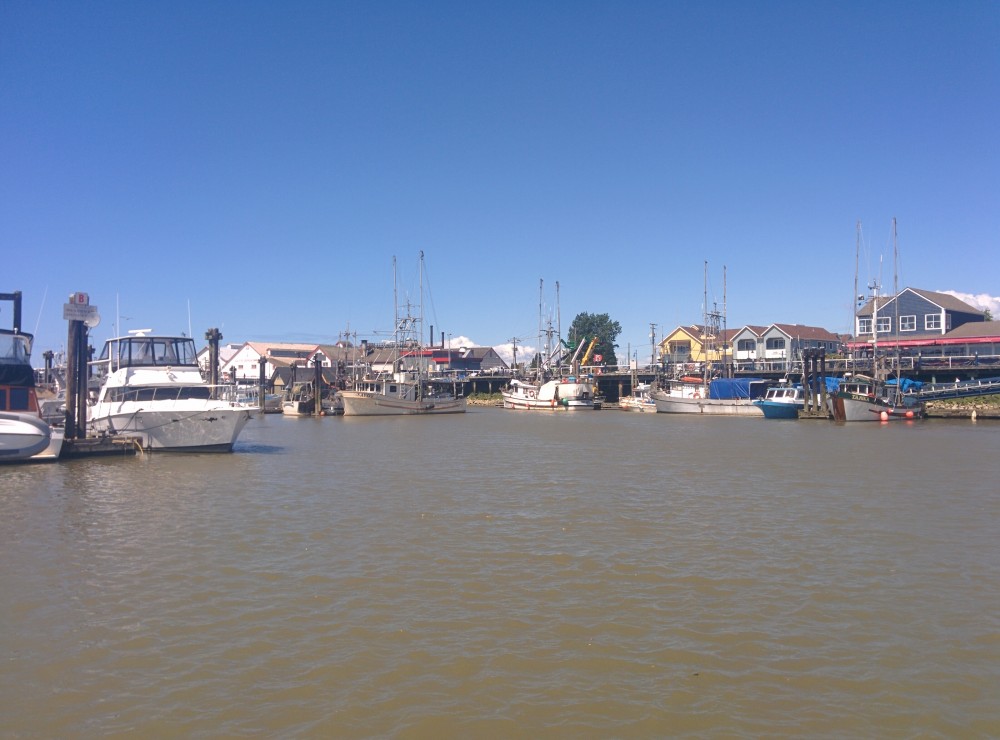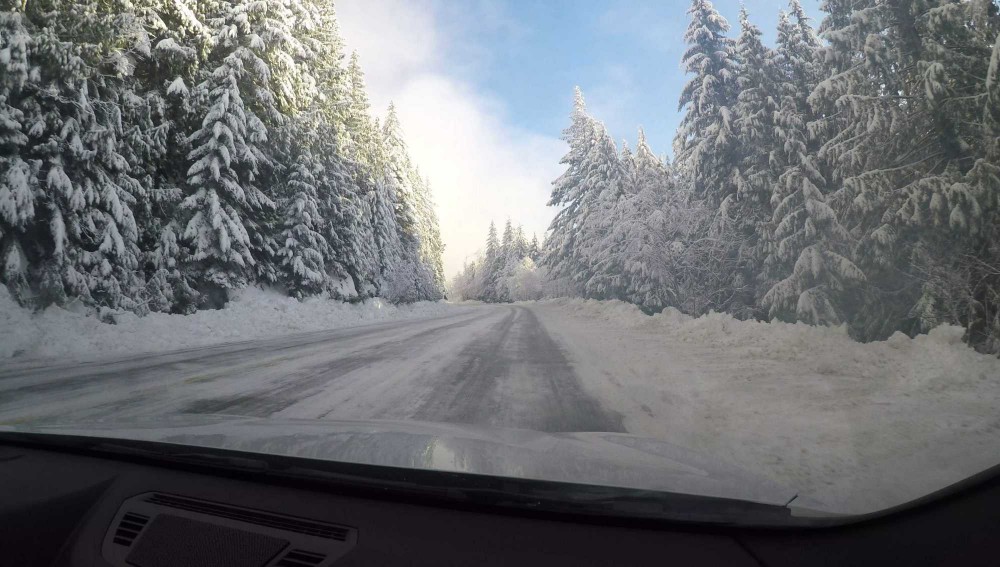
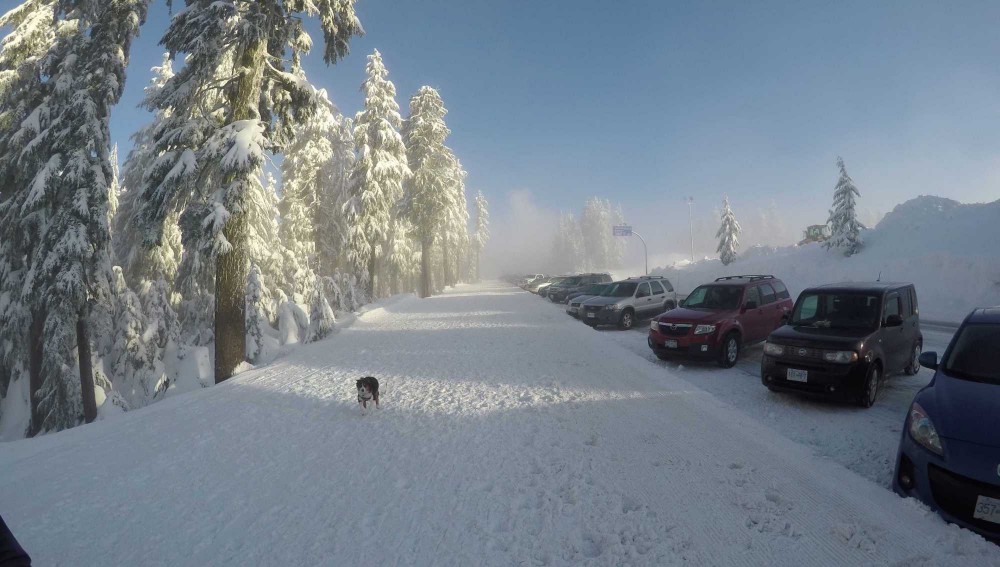
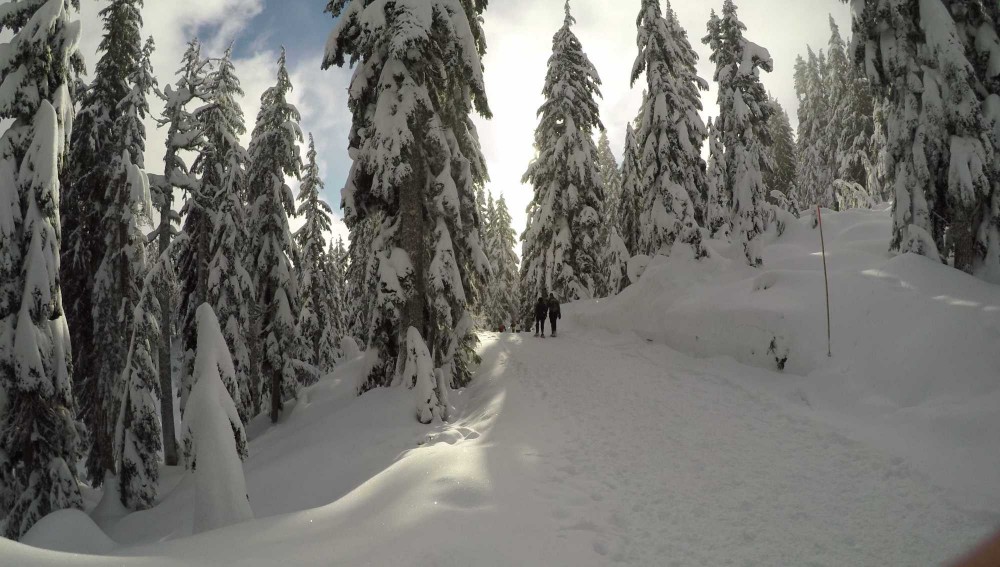

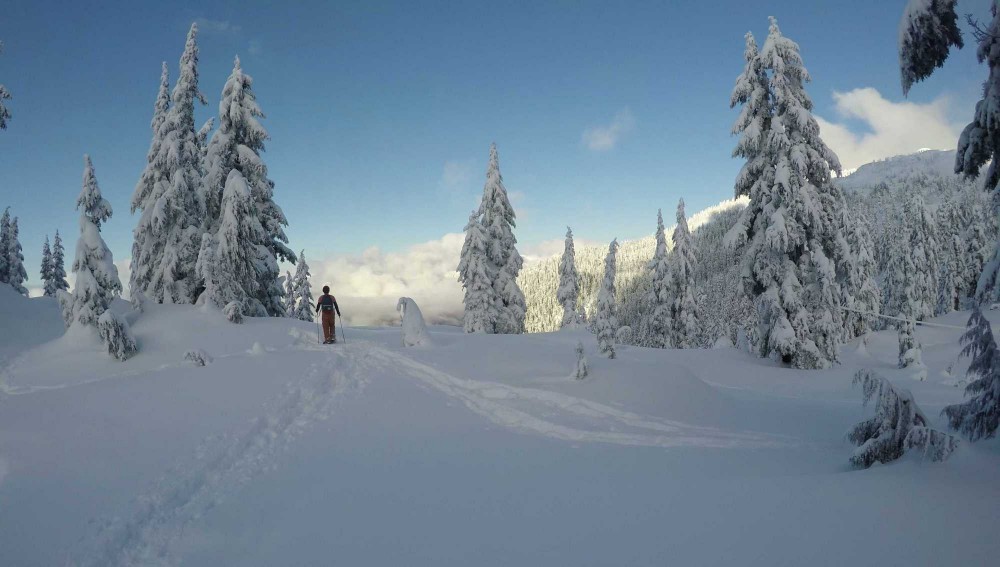

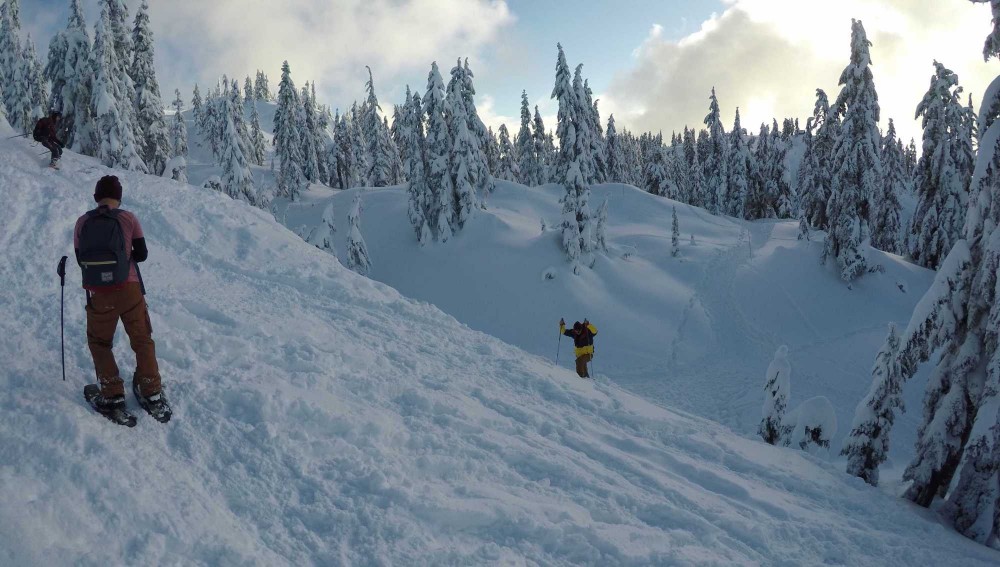

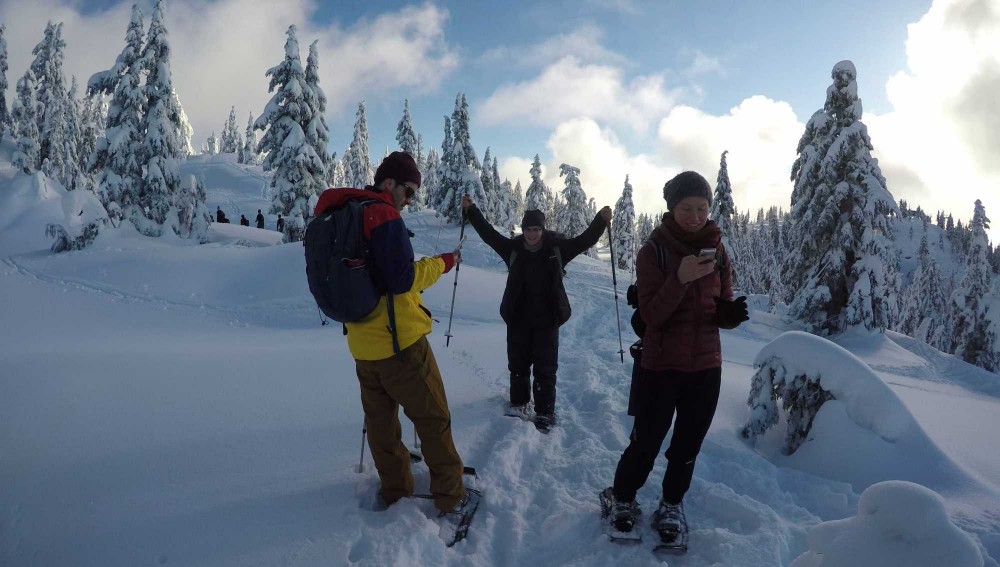

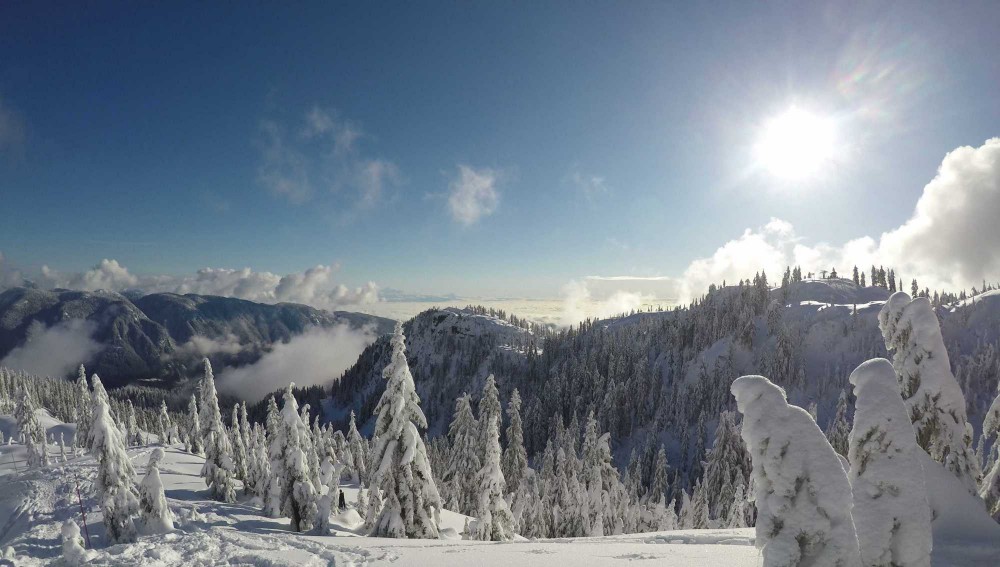
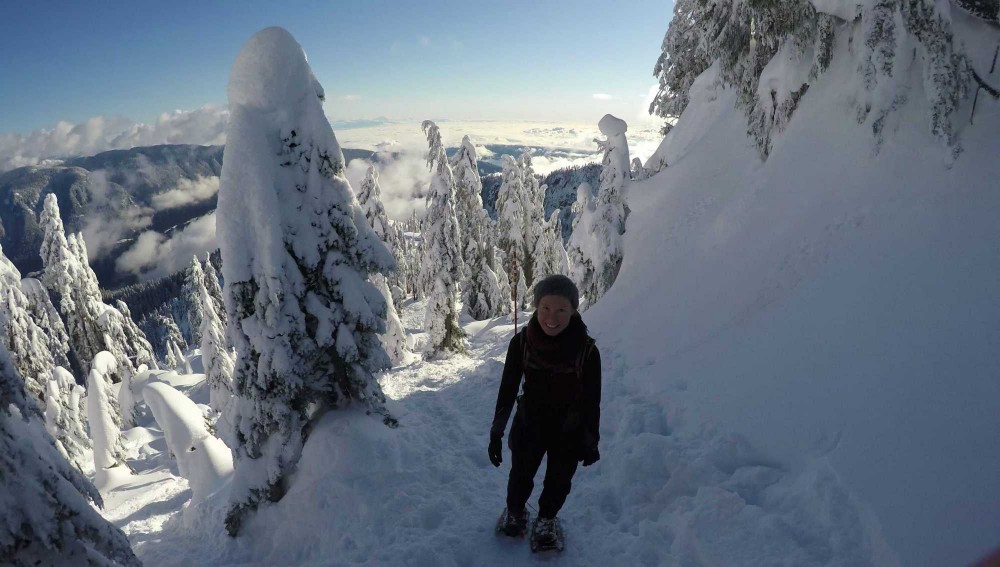
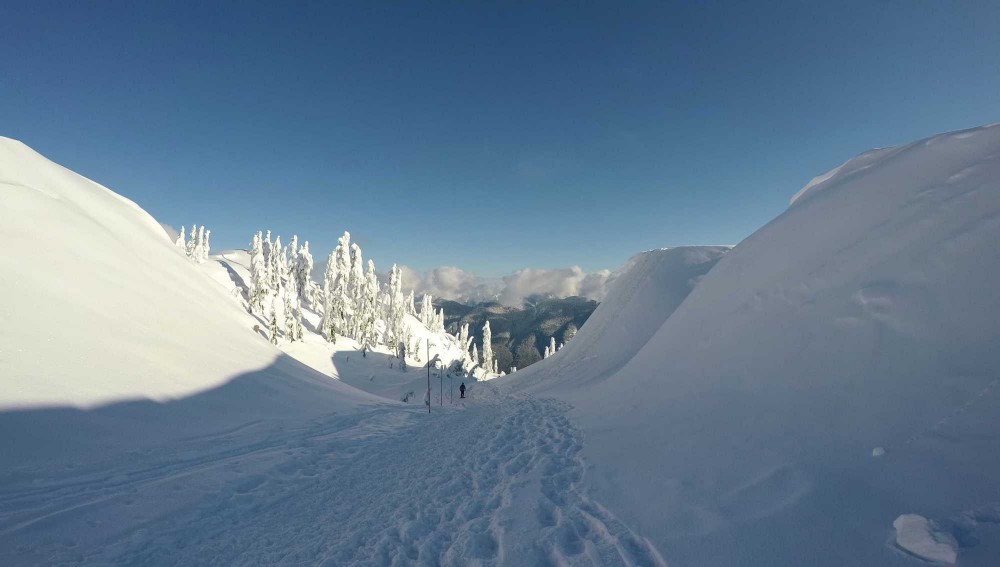
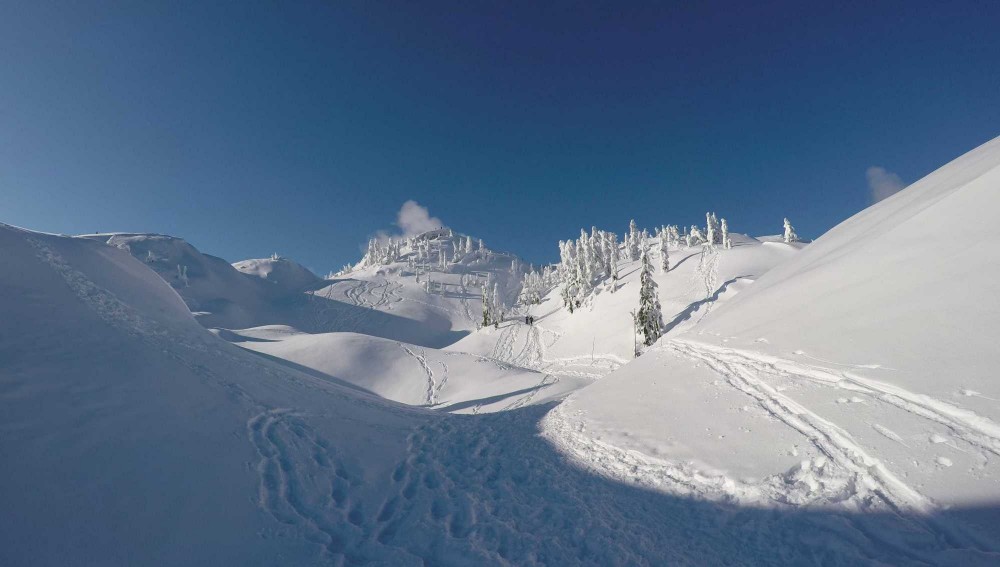
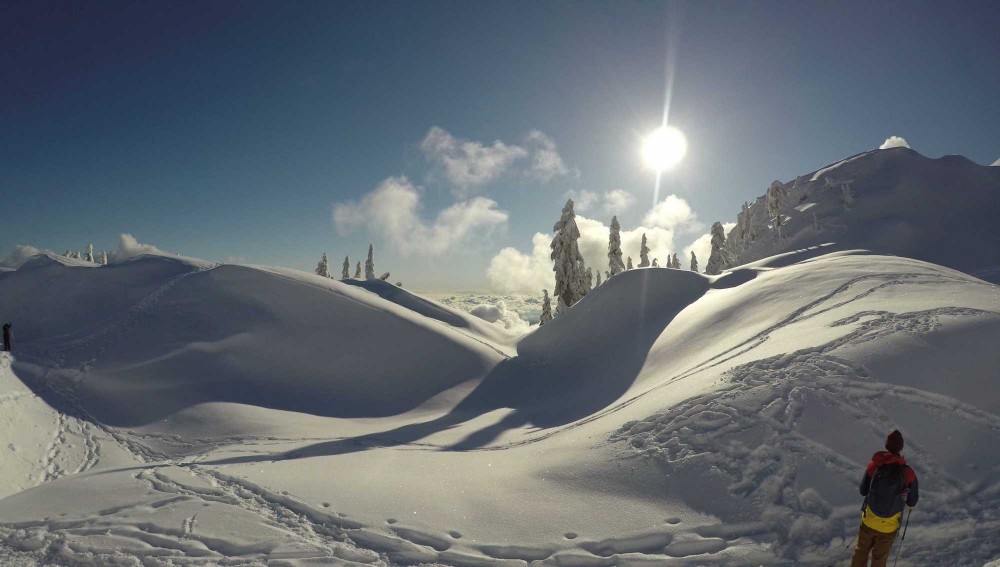

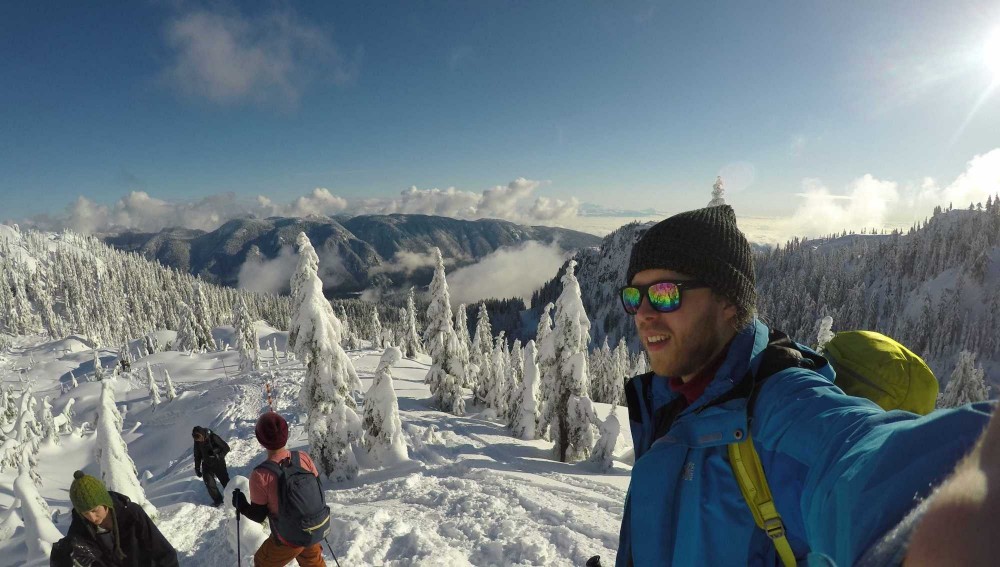
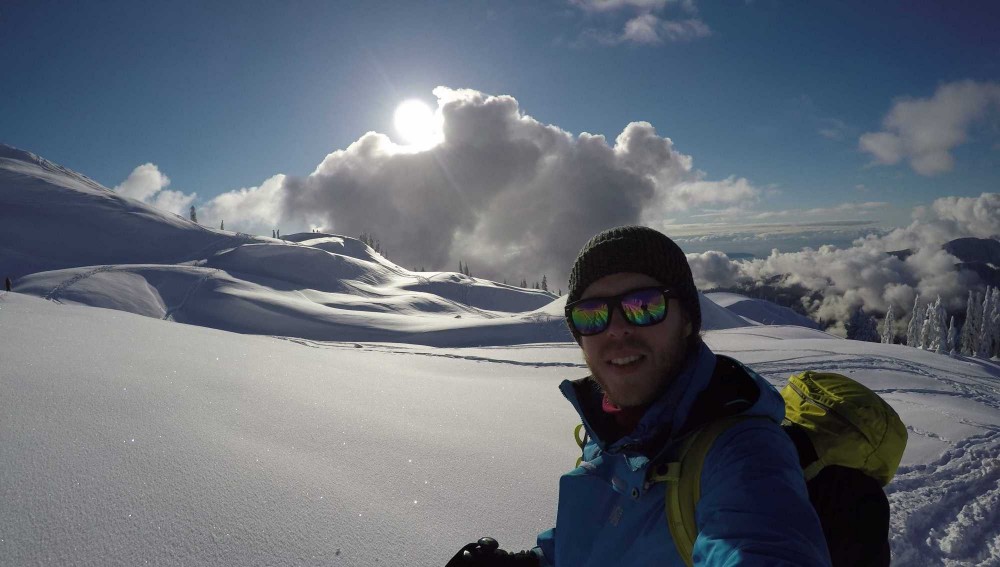
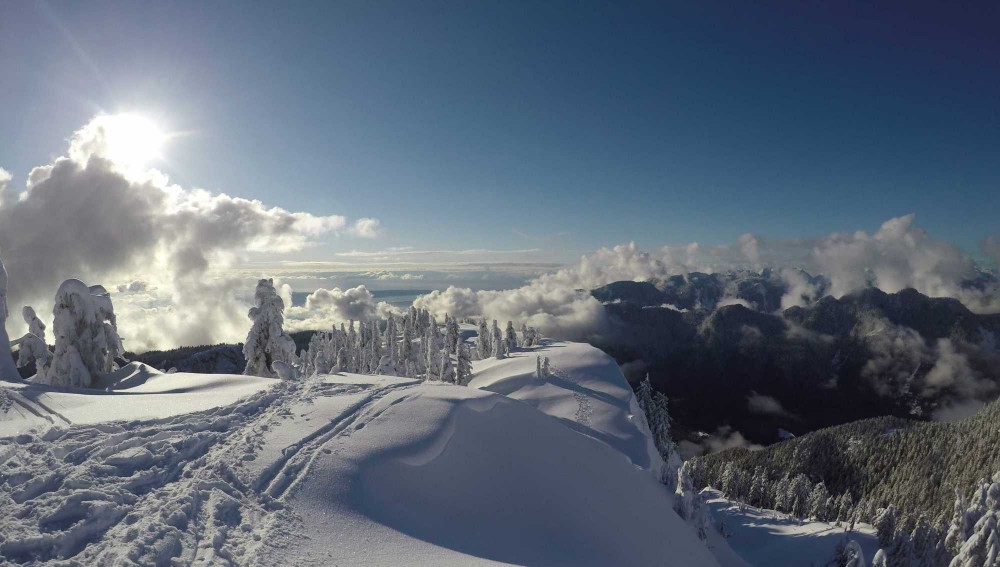

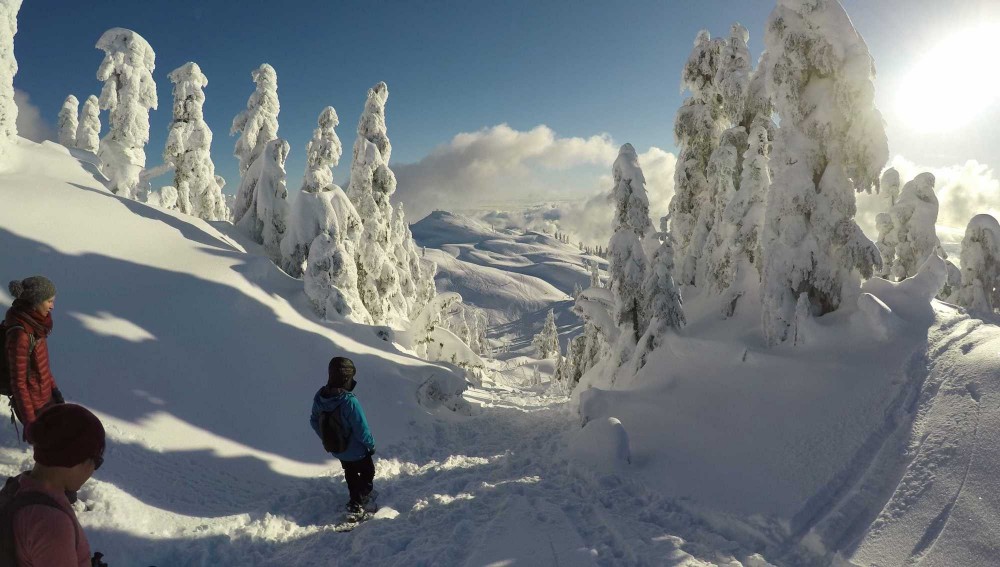
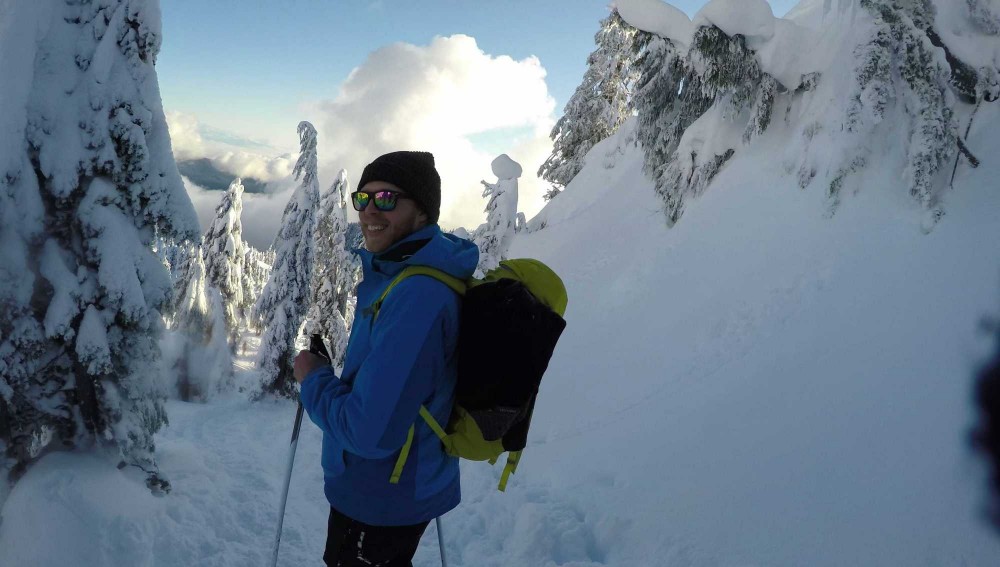
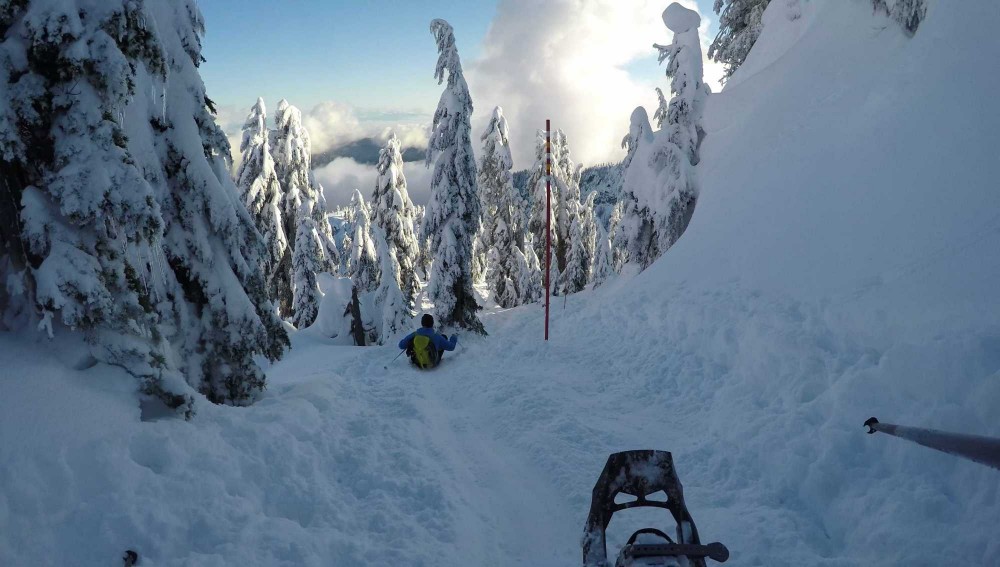
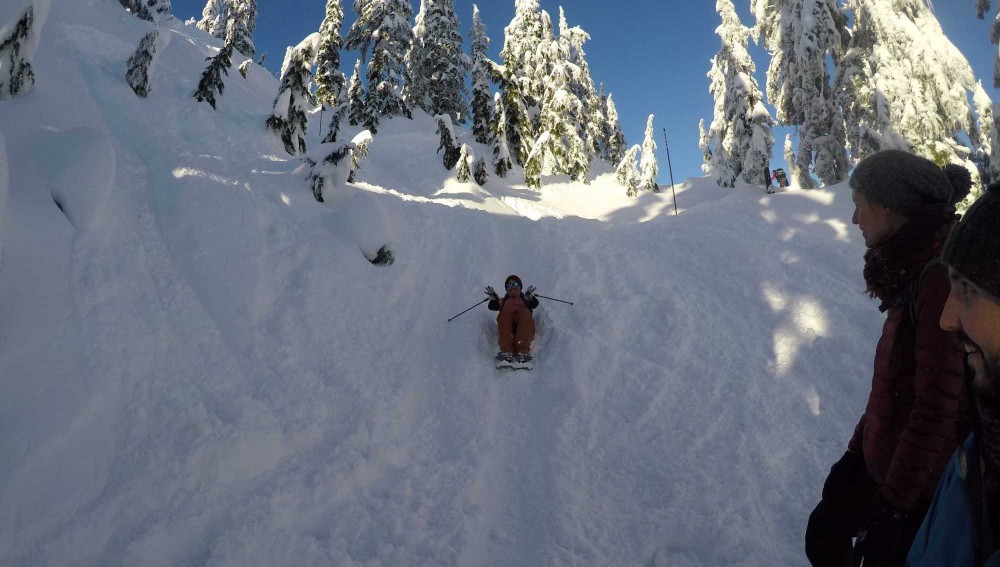
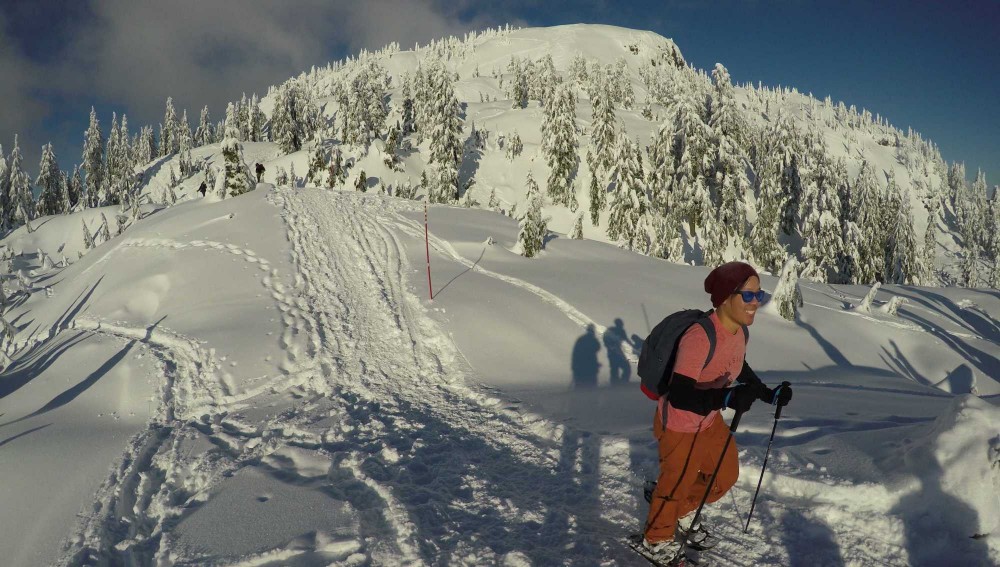

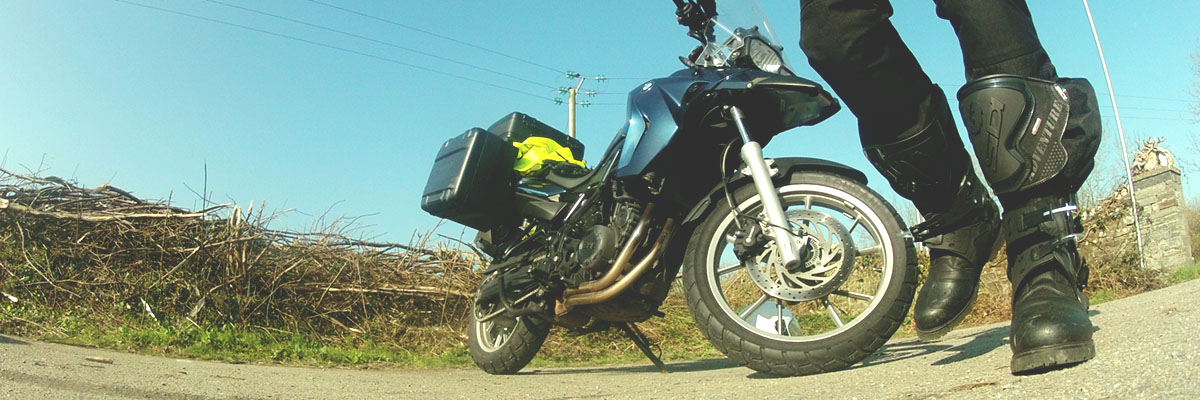
One of the main reasons for me to return back to North America last year was my wish to explore the breathtakingly diverse landscapes of this continent. High up on my list was Yellowstone National Park. After a lot of hassle getting my gear together and the bike ready for a longer trip I was almost ready to set off to Yellowstone National Park, Wyoming, USA.
Before leaving Vancouver in early July however the first challenge was to pack the bike. On a motorcycle there are several things to consider in regards to your travel luggage. One being the balance of the bike. The weight has to be distributed evenly which is particularly important at higher speeds, off road, in corners and during strong winds. And at normal speed. Yes and always. The next thing is of course the weight of the luggage. You have to leave things behind that you might consider essential. There simply ins’t enough room. However I actually like this aspect because it makes you realize and decide what you truly need and what you don’t. Not just on a journey but altogether. If you don’t need it on such a longer trip you probably don’t need it at all. I have reduced my kit to a bunch of mechanical tools, emergency medical equipment, camping gear, toiletries and the bare minimum of clothing. The only non essential equipment I always take with me is my camera gear.
The biggest issue with weight for me usually is the suspension travel. The suspension (essentially the big metal spring on the rear wheel) has to be capable of supporting the added weight without ever compressing fully. Not off road and especially not on road. Unfortunately the KLR doesn’t have a greatest of suspensions.
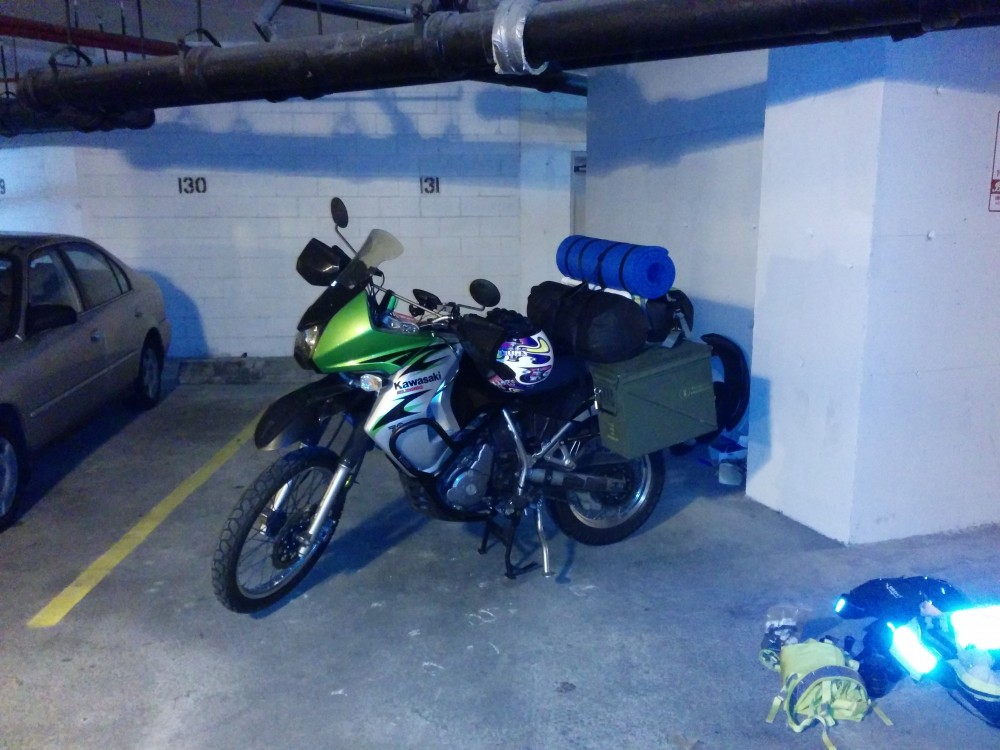
I set the hardness from it’s original level 1 to the maximum 5. But the difference was barely noticeable.

A few extra pieces of equipment like two 1.5 liter jerry cans (additional fuel) I had already discarded. The only thing non essential left was my camera equipment. My DSLR camera is heavy and together with additional lenses it added 10 pounds to my luggage. Because safety always goes first reluctantly I decided to leave my camera equipment at home too.
The final aspect of packing a motorcycle is ease of access to your gear on the road. Stopping on the way to get a small piece of your equipment out and back stowed away safely so you don’t lose it on the next bump may take 15 seconds in a car but 15 minutes on a bike. Every stop you make on the bike takes that into account. So things like Passport, rain cloths, extra layer for warmth, water.. go at the top. I find that this issue of accessibility is probably the most exhausting and draining part of travelling on a motorcycle.
After having found a setup that worked (so-so) I tested the suspension on last time by letting myself fall onto the saddle as hard as possible, set the GPS target to the US border and I was on my way to a new adventure.
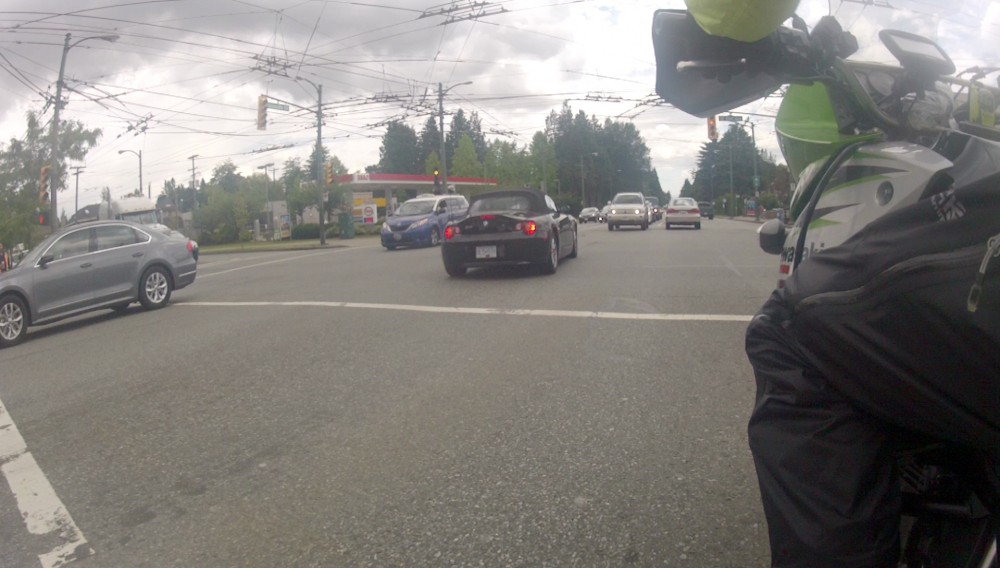
The weather was just semi great (=bad). It was already raining lightly and it was supposed to get worse. In anticipation of a wet first day I had already started the trip in my full rain gear and all warm layers just to be safe. Once you are caught in the rain there is no quickly slipping into another layer. It’s too late by then you’ll be wet.
The weather report promised heavy rain once I would cross the border.
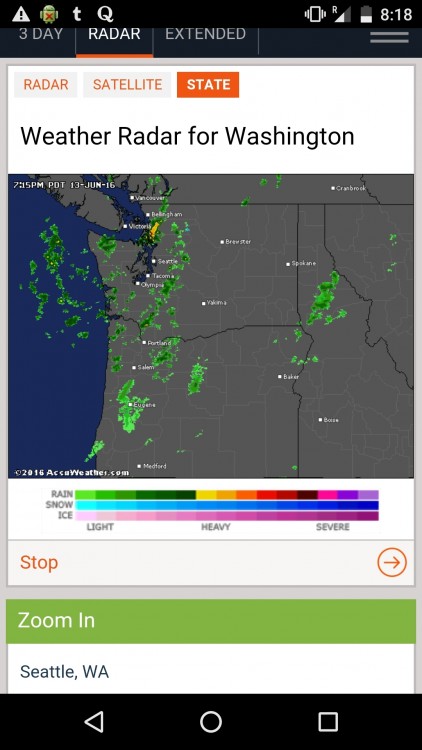
Luckily that didn’t prove to be true so after crossing the border I took a little break to take off my weather armor. It’s not the most comfortable feeling to be stuck in so many layers which really restrict your movement.

All along the way I had kept a close eye on the suspension trying to get a feeling for how bad things really were. I had now done a few docents km and reached the conclusion that there still was some suspension travel left. So little that I would feel every bump but not too little to be overly concerned. In fact I became confident enough that I actually decided to turn around to go get my DSLR camera. Everybody who knows me knows that not having a camera is a real problem for me so I didn’t think about it twice. Luckily the border is quite close and I only lost two hours until I was back again in the US and on my way towards Seattle.
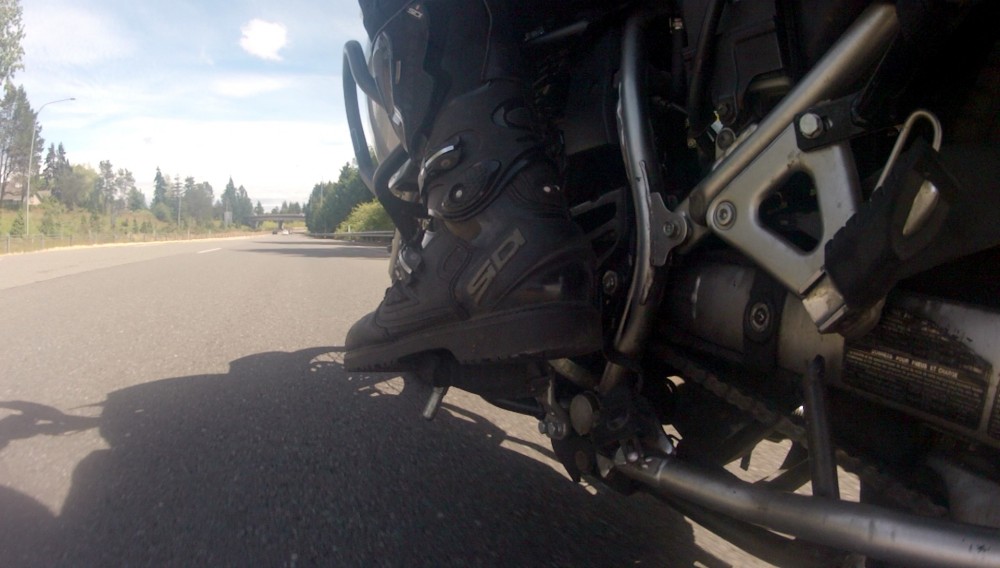
Of course I was soon putting my rain gear back on because the weather started getting bad again.
Not a second too soon.
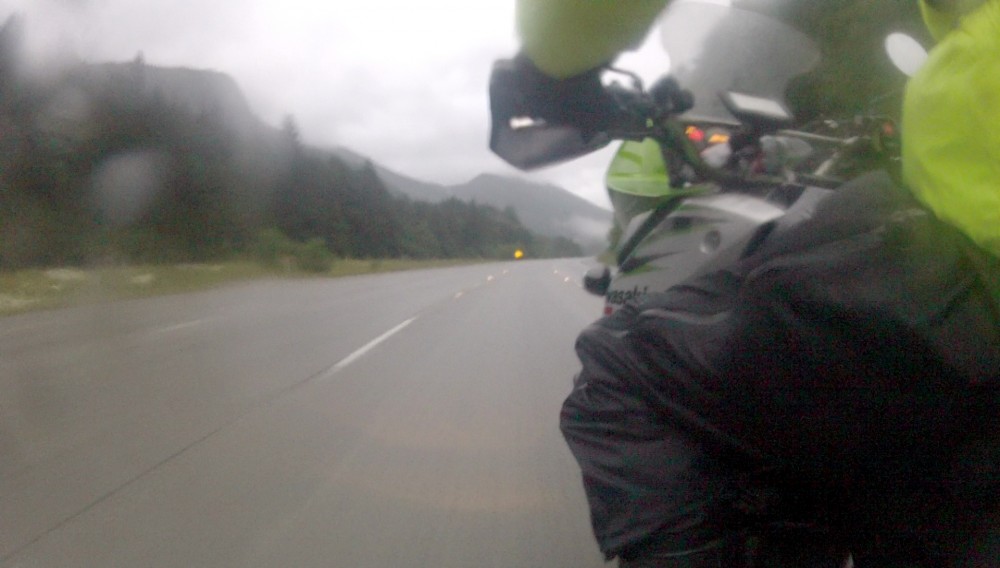
When planing my trip the only thing that had worried me was whether the time frame I had for it was a little too early to have good weather throughout. Now it seemed like that was the case. But since there wasn’t any point in complaining I kept pushing on to get as far as I could across the mountain pass I was now on. It was the reason for the drastic change in weather. Within 20 minutes I had climbed from sea level to 1000m.
Luckily I didn’t need to stop for gas very often thanks to the KLR’s gigantic 23 liter fuel tank. The gas prices weren’t too inviting anyway.
I was now looking for a camp site in the pouring rain and to my surprise I found one not too far off the main road after a kilometer of pothole filled dirt road. I wished I had already had my auxiliary lights installed to help me see in the dark. Especially because the heavy load on the rear of the bike lifted the angle of the regular lights. Of course the lights should be adjusted after packing the bike but I didn’t think about this before I left. I would have had to take the bike apart too and I didn’t have time for that on the trip. Especially not now.
The camp site I had found was not what a European would expect from a camp site. In Europe camp sites are usually fenced in, with facilities, probably a power outlet, maybe even a kitchen, and certainly somebody to welcome you and take your payment. Avoiding this was the reason I chose wild camping in Spain but to my delight there was no choice here. This camp site was just a road branching off in the forest and a hand full of clear spots marked with little numbers on wooden signs. You were supposed to take an envelop from a sign post at the ‘entrance’, providing your details, put the fee in it and deposit it in a letter box. Then you would just go and pick any spot and put up your tent. Very simple. I liked that. So I chose a spot -I was the only one there anyway-, put my bike in front of the particular space I wanted to put my tent on and started pitching it in the light cone of my headlight. It was still raining so I felt a bit miserable but having done this a few times before it only took 10 minutes to set it up and soon I was laying in my dry comfy sleeping bag falling asleep to the sound of the rain pattering on my tent.
To prepare the bike for bigger trips and heavier off-road use I decided to add crash bars to the frame. Doing that requires the bike to be partially taken apart. Because this is an annoyingly time consuming task I decided to catch two birds with one stone and also work on the wiring of the bike to prepare it for the auxiliary lights I wanted to add later for increased visibility off the road in the dark.
First I had to take off all the fairings of the bike. This is where you can notice the difference between a BMW (expensive) and a Kawasaki (cheap). You have to take the bike apart for everything and they don’t seem to have done anything to make it easier for you.
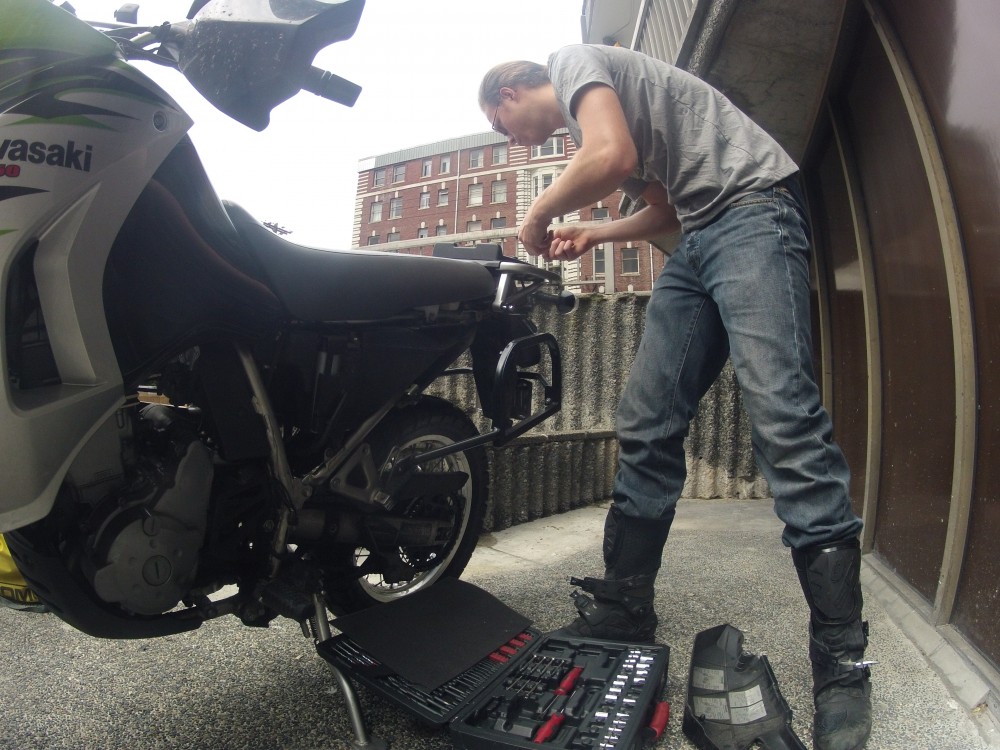
So to access the battery alone you have to unscrew the the luggage rack and the rear fairings. The seat and another cover for the battery. On the BMW I just twisted the ignition key and the seat came off, immediately revealing the battery. Looking at the bright side it is really difficult for any unauthorized person to temper with the internal elements of the bike.
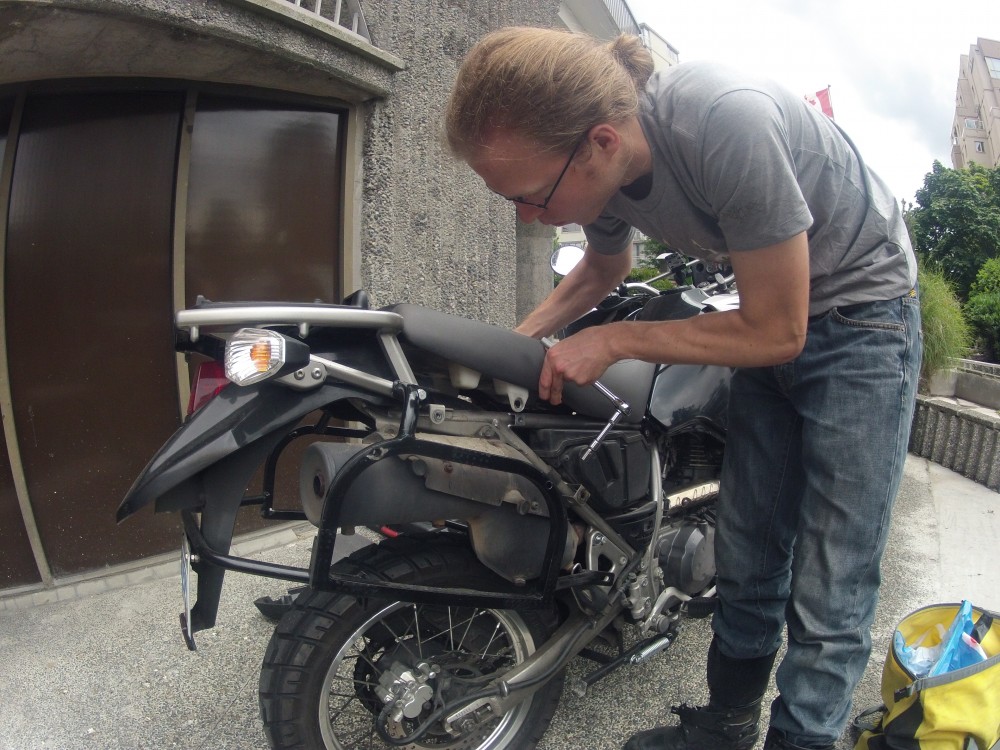
Imagine you just want to ‘quickly’ check the voltage of the battery..

Anyway once that was done I took of the front fairings …
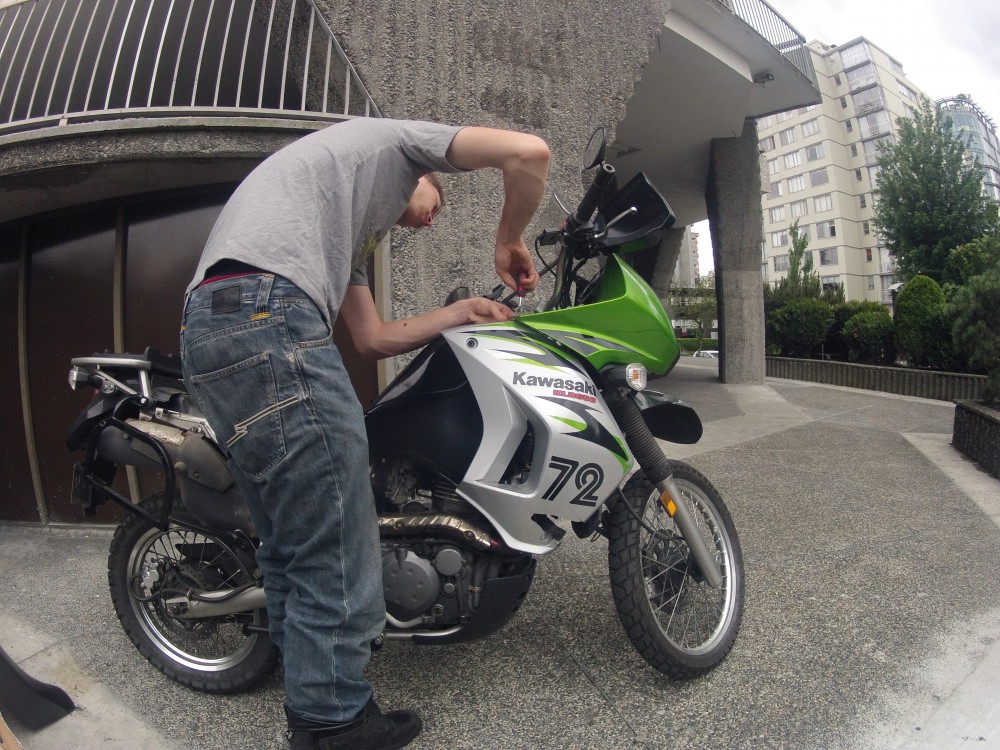
… and the skid plate that protects the underside of the engine.

The bike started to get lighter.
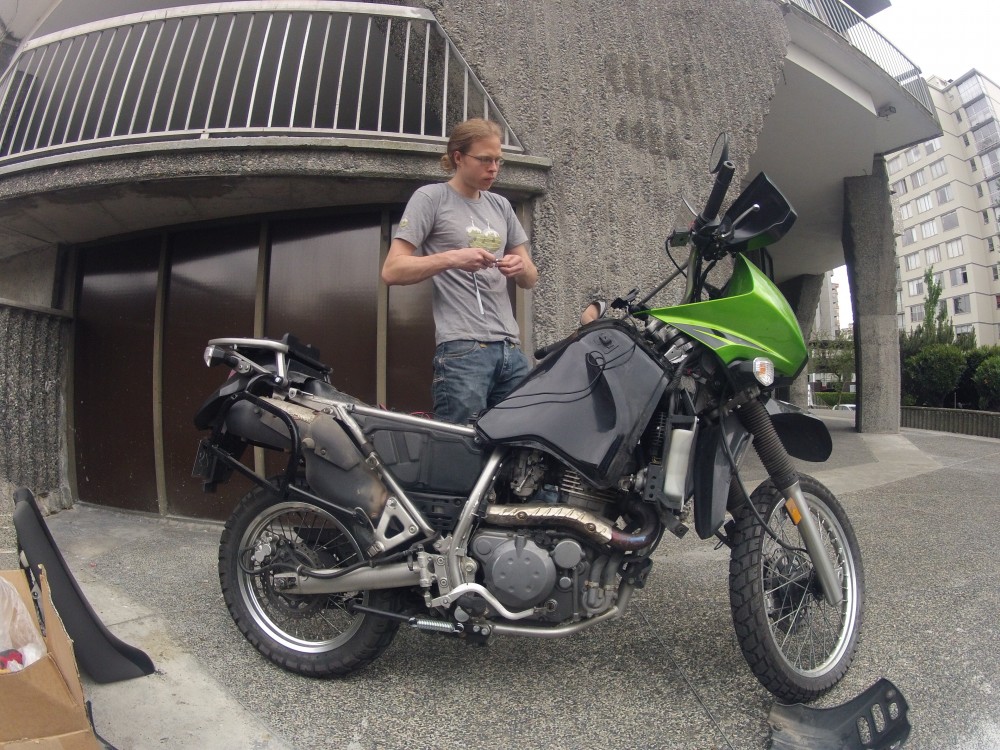
The last element I had to take off was the gas tank. To do that I needed to disconnect the fuel lines from it.

After finally taking off the tank the real work could begin.
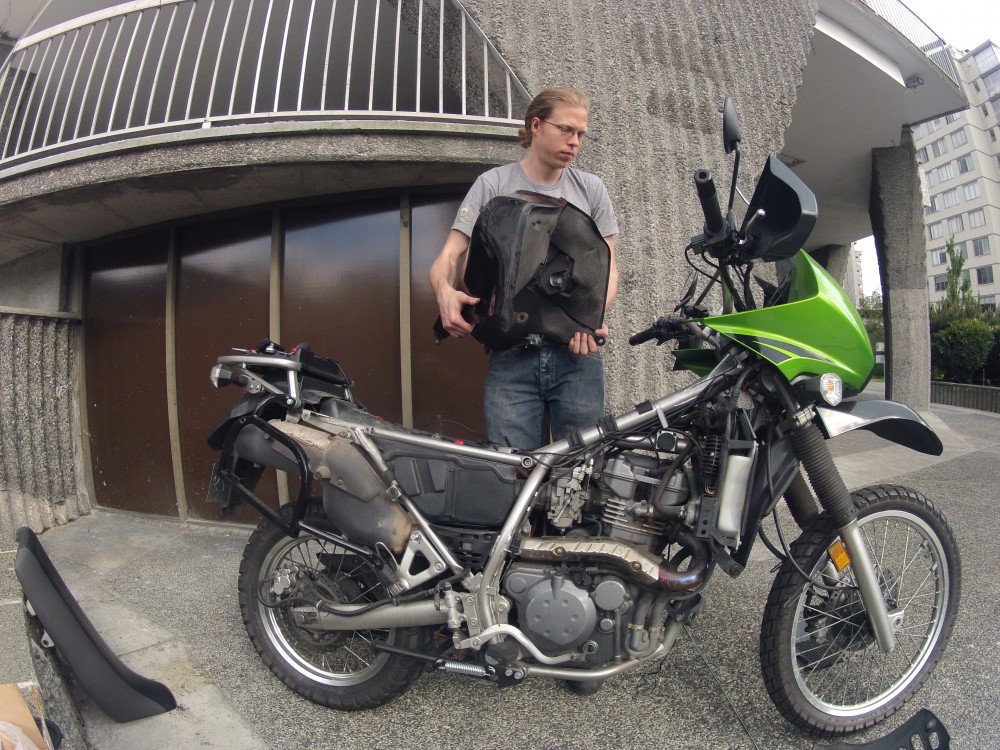
The KLR doesn’t really offer much room for altering the electrical elements.
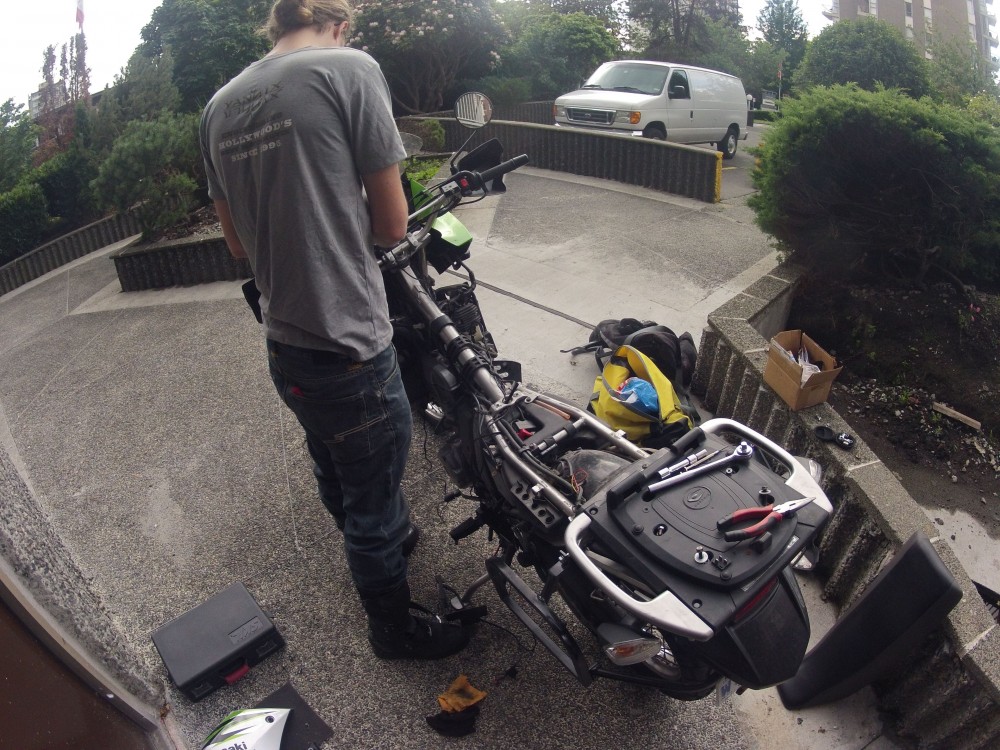
But I managed to keep everything compact so that I could put the tank back on.
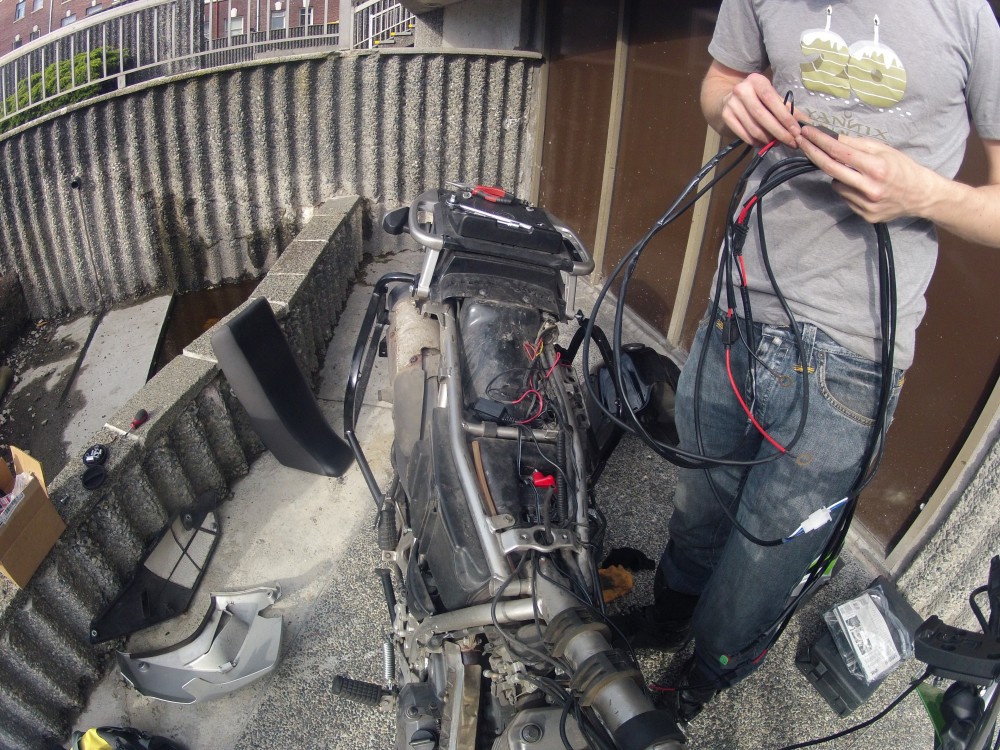
Now I could start with the installation of the crash bars.
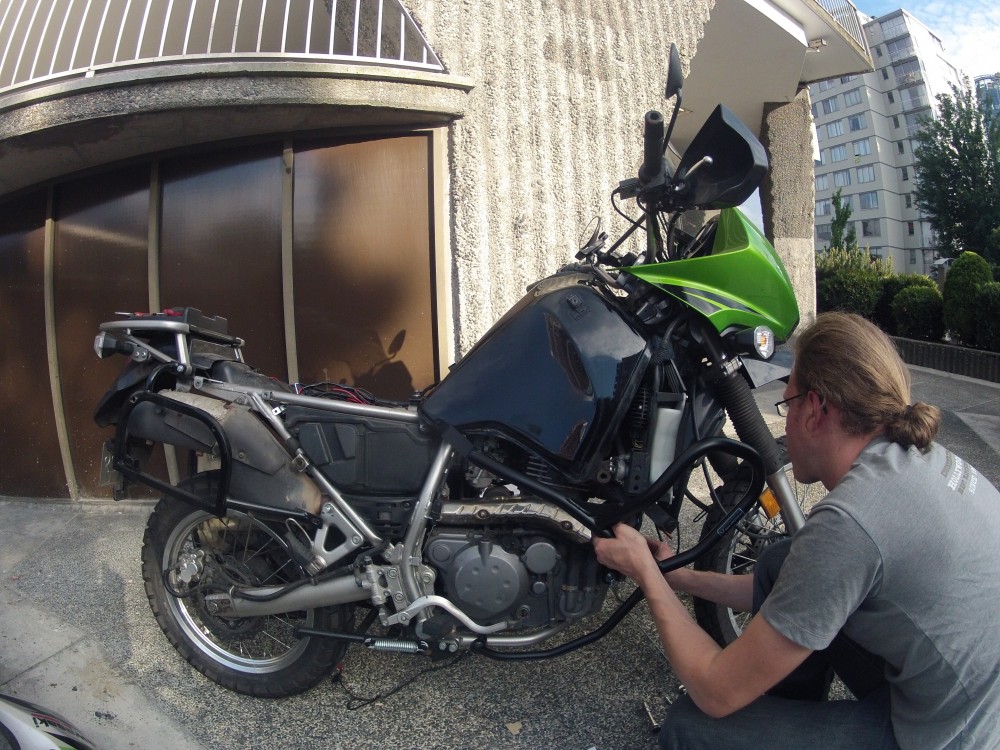
The bars connect to existing bolts that keep individual frame elements together. They needed to be taken out and longer screws put back in in their place so that they would secure not only the frames elements like before but also the added crash bars. These original bolts are fastened with extreme force so the bike doesn’t fall apart on the road due to the intense vibrations that can otherwise easily loosen a screw. So to loosen these bolts I applied a big amount of force thus actually breaking my bit socket before the first screw came loose.

This was the last weekend before my next big trip and I had to get this work done quickly so I went to the home depot (‘Obi’ in Austria) and got a set of Allen keys. These ones would certainly not break as easily and would allow me to apply even more pressure due to the leverage they provide by their shape alone.
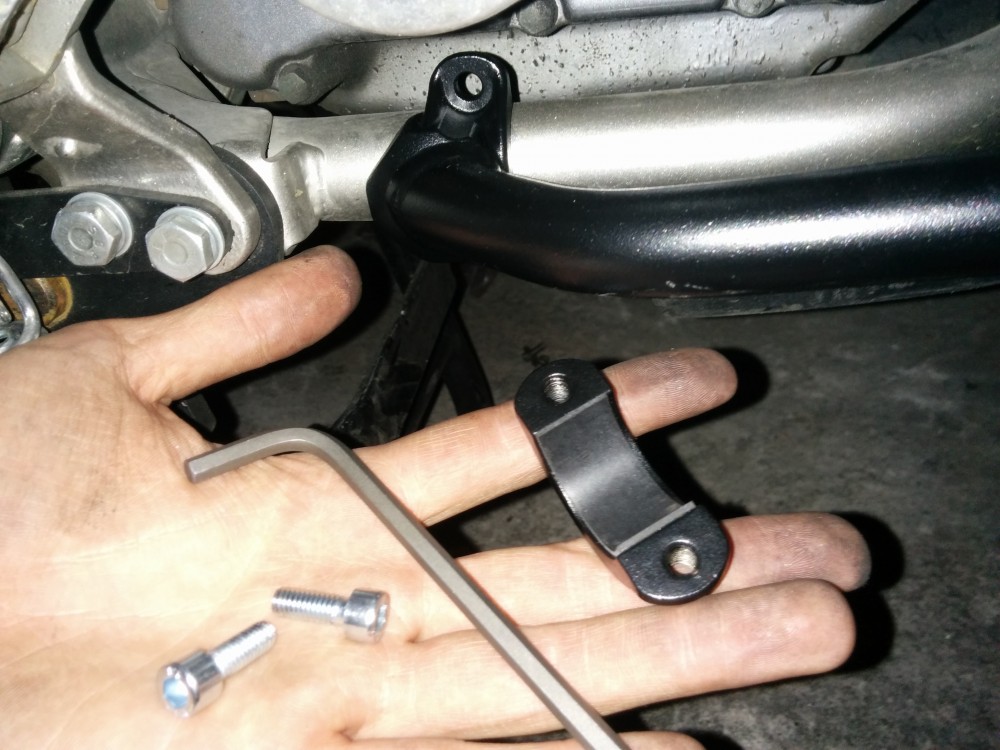
Finally the bars were mounted.
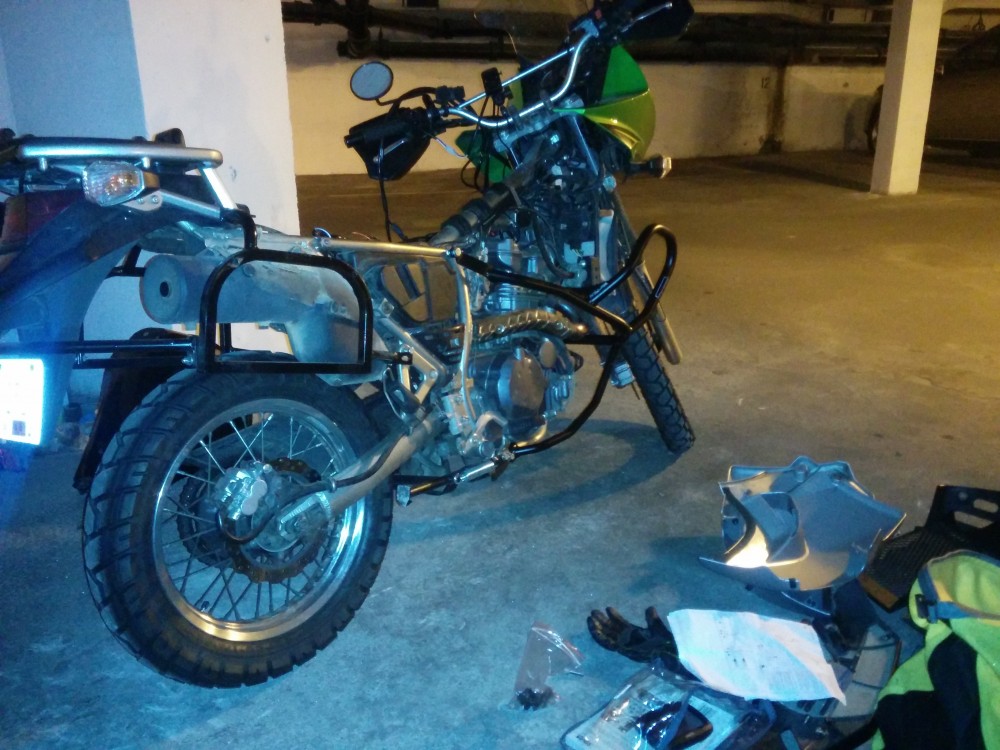
I reattached all the parts I had taken off before. Besides the added protection this new setup would now provide me with a place to mount auxiliary lights.
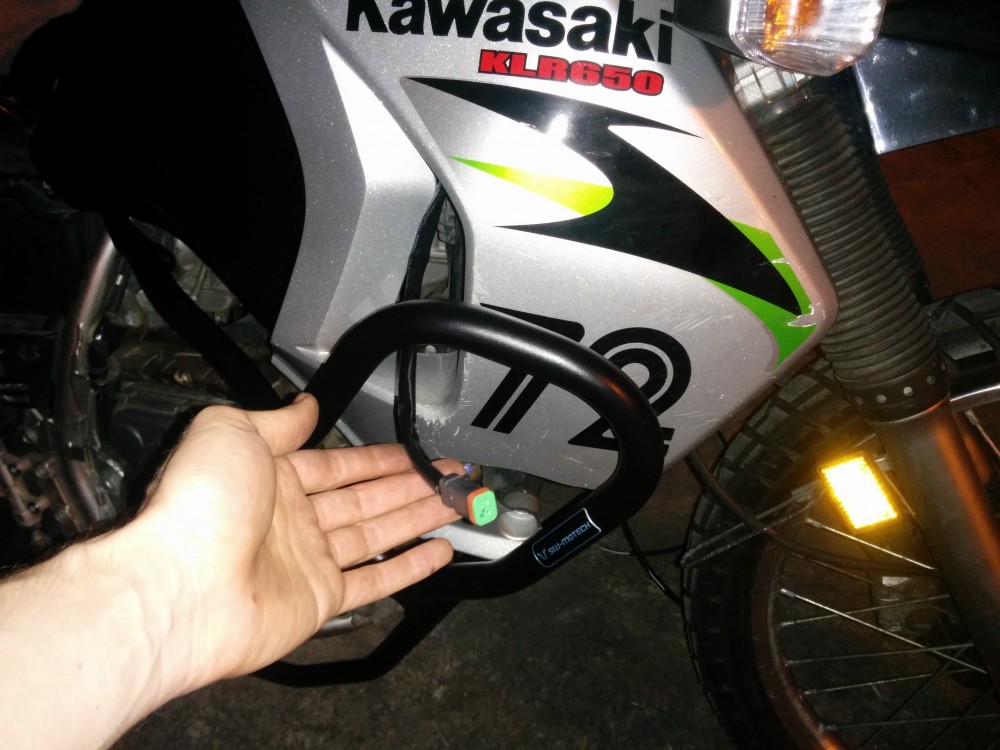
Now the KLR was ready for adventure.
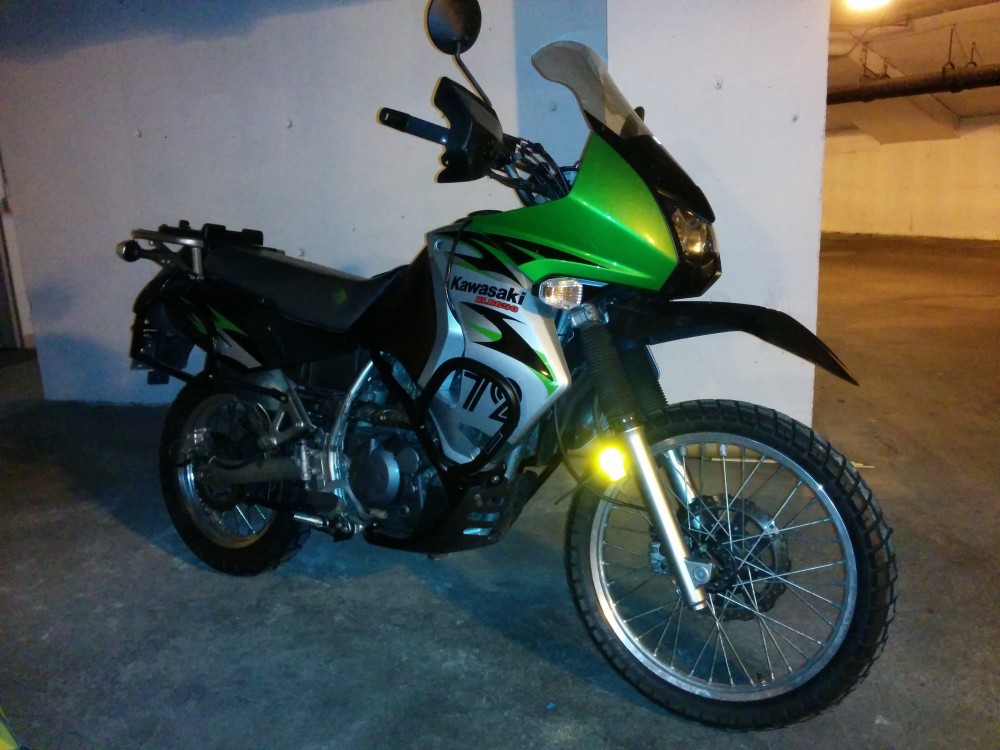
A little while ago I had noticed that the oil level on the KLR was extremely low. I hadn’t checked it much previously because I didn’t think it would be necessary after just a few hundred kilometers. The 2008 series of the Kawasaki KLR 650 however is known for burning oil like crazy and despite the previous owner claiming that this particular example does not suffer from this condition it turns out it very much does.
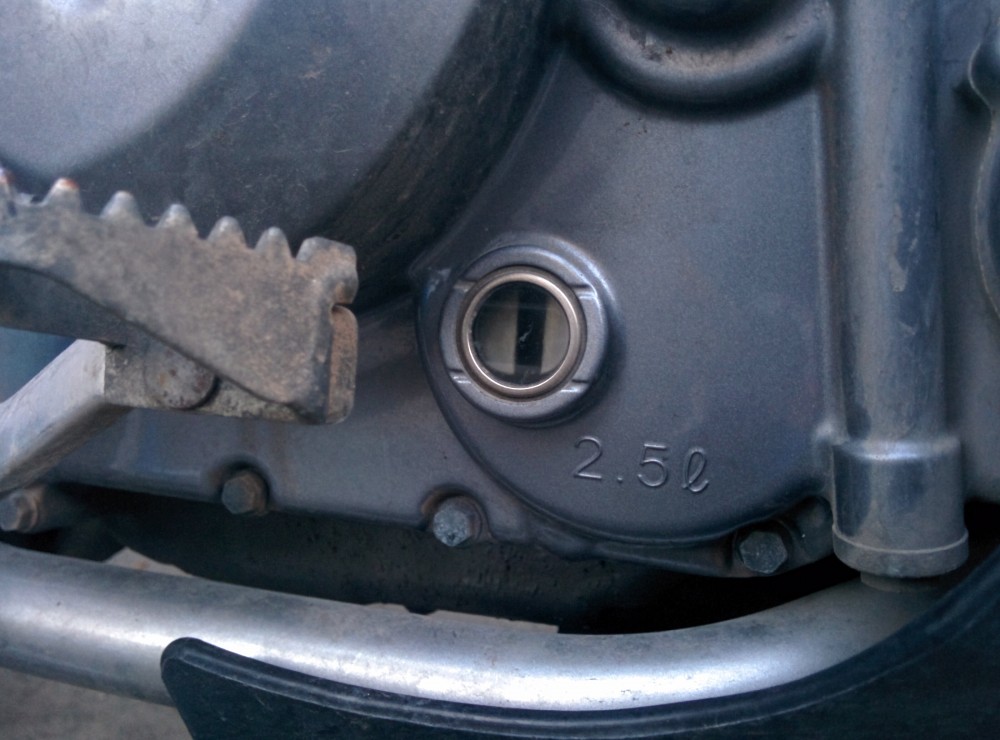
Driving with low oil is of course very dangerous and can lead to damaging the engine and possibly locking up the piston(s) and as a result the rear wheel while driving. On a motorcycle that wouldn’t be exactly great. So the engine needed more oil. The gauge on the engine block shows empty but simply adding fresh oil is not a good idea. There is always some old oil left in the engine block. Much more than what the gauge might lead you to believe. On the one hand that means that possibly the situation is not as bad as it looks and you might still be able to drive but on the other hand it also means the remaining oil has to come out before adding fresh oil. The oil consistency and quality degrades under the extreme stress in a running engine and again would eventually clog up and damage the engine if it was left in there and just filled up with additional fresh oil.
So the proper procedure is to always drain the engine completely and refill it with (in this bike’s case 2.5 liters of) fresh oil. From time to time the filter which assures the cleanliness of the oil in the engine should also be replaced with a new one. Since I had no idea when the filter had last been changed on this bike (if at all) I decided to do that too while I’m at it.
I used an empty laundry detergent container to catch the oil from underneath the bike after screwing off the plug at the underside of the engine.
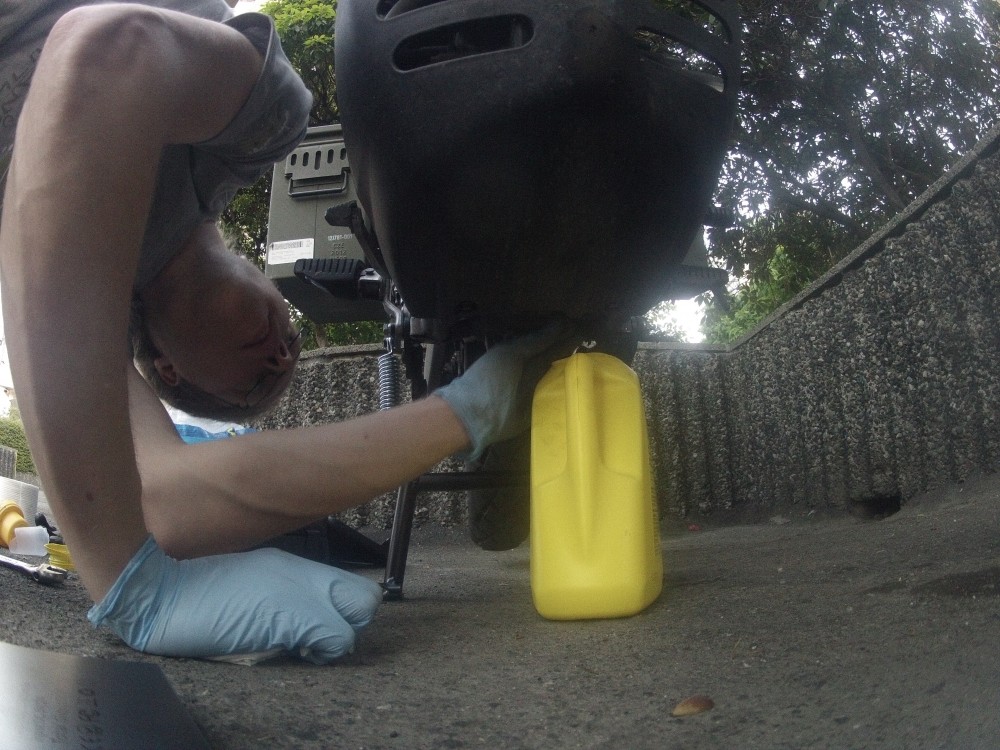
After a few minutes the flow had reduced to a trickle and eventually stopped completely. Just like honey the oil flows easier when it’s warm because it gets thinner so it is a good practice to run the engine for a few minutes before an oil change. Not too long though so you don’t burn yourself when you open the cap and it starts flowing all over your fingers which is almost unavoidable.
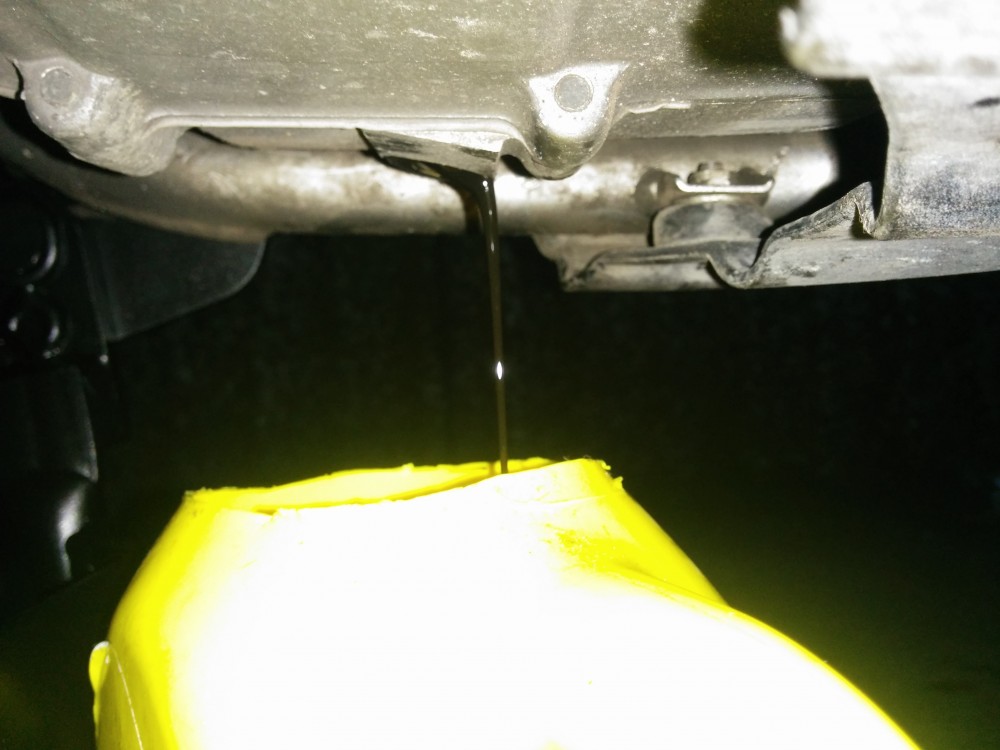
Next I took off the cap on the side of the engine that revealed the filter and removed it.

I cleaned the filter barrel (not sure what it is called) …
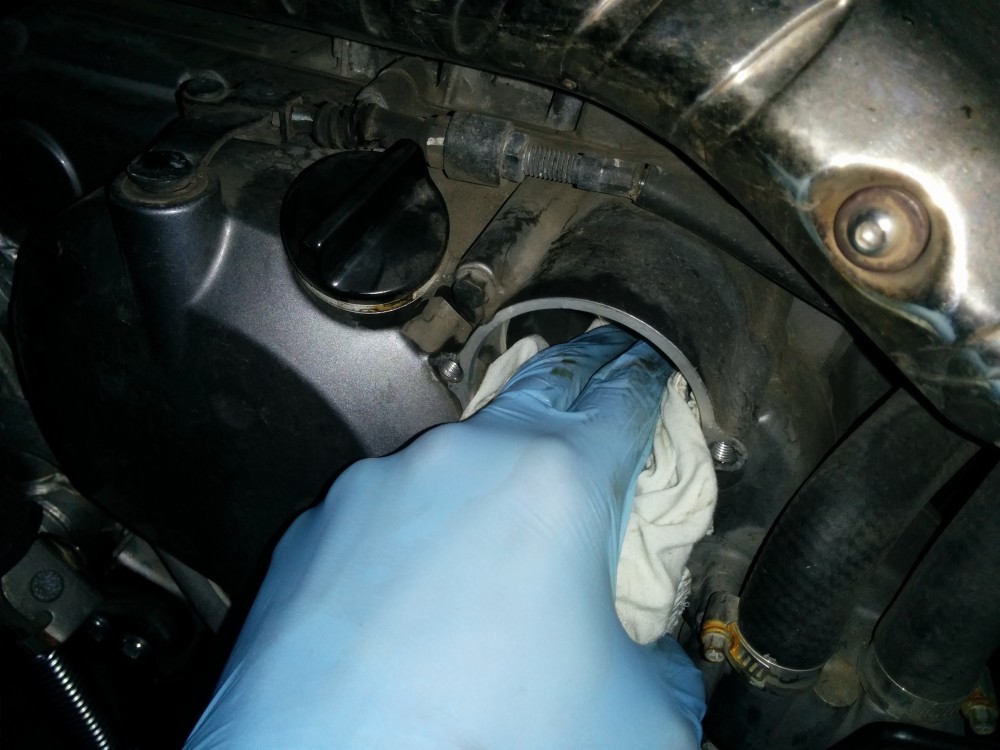
… lubricated the new filter with fresh oil …

and put it back into the barrel.
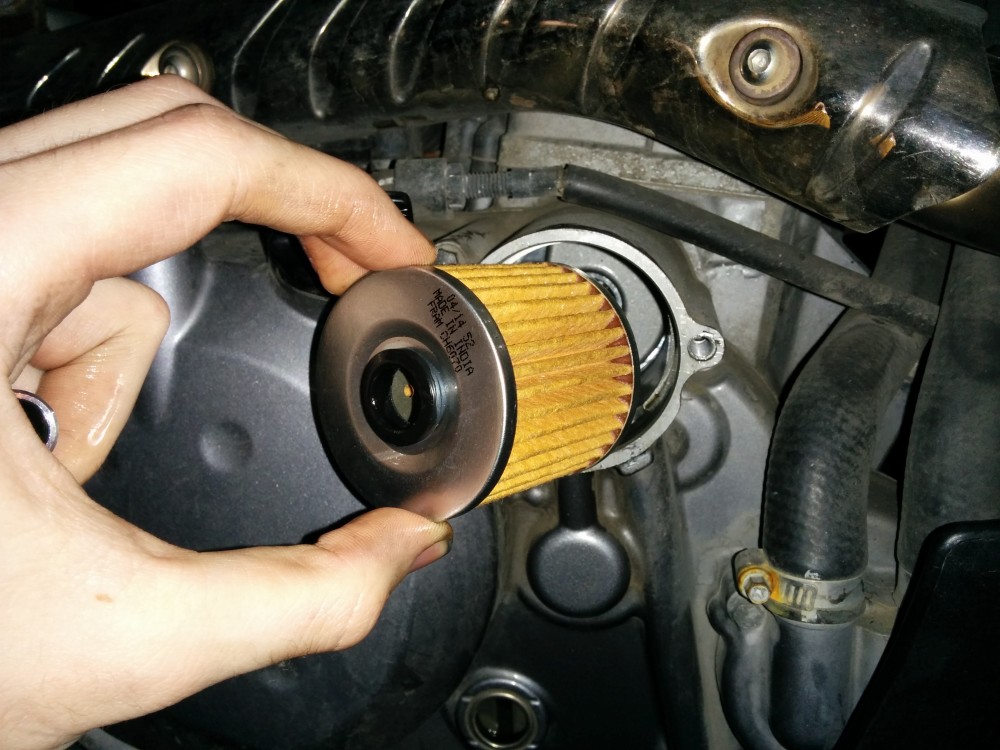
The last step waso t close the barrel again …
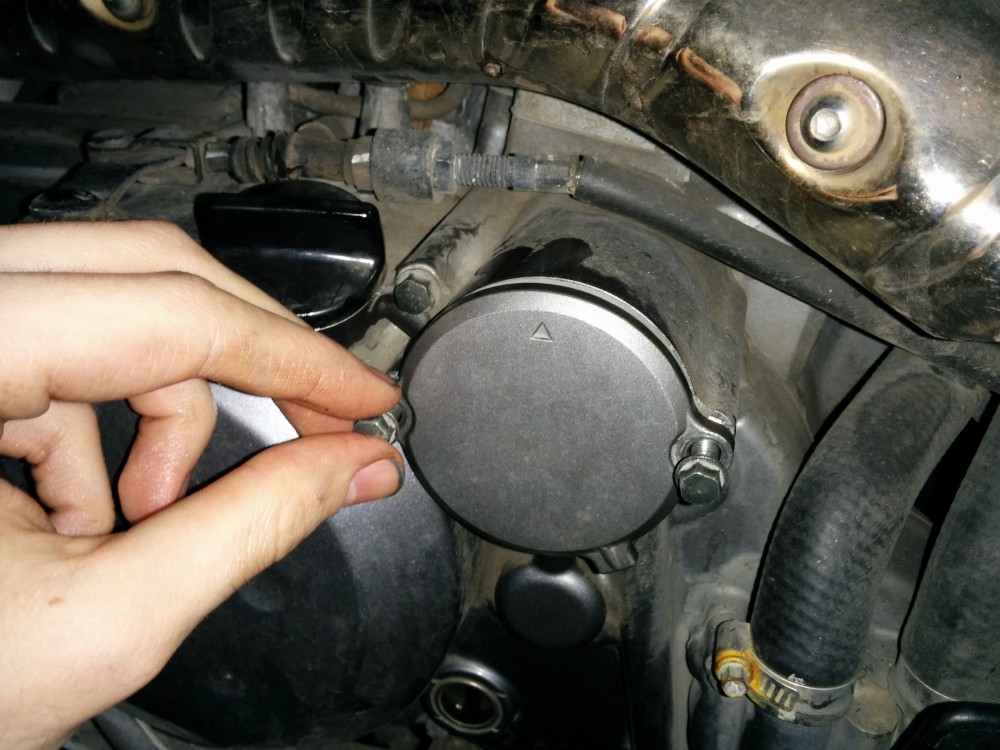
… and put 2.5 liters of fresh oil into the engine via the opening on the top right above the clutch compartment. As you can see the little gauge at the bottom of the engine is now filled to the top line again.

With the temperatures rising and Summer around the corner I decided to take a little trip. The destination: “Hope”, a tiny town in the British Columbia woods North East of Vancouver which would not probably go unnoticed if it wasn’t for Sylvester Stallone and Ted Kotcheff who created one of the most iconic and well known movie characters of all time in this little town in 1982. The movie filmed there was First Blood which kick started Silvester Stallones movie career.
The Canadian town of Hope was chosen for it’s somber, triste feeling and remoteness and the fact that nobody had ever heard of it let alone knew it was in Canada. It was supposed to be just any random unimportant small towns in the US.
Before we begin a tour through the town let’s set the mood with Dan Hill’s First Blood end credit’s song.
One of the first scenes shows John Rambo entering the city which welcomes its visitors with a giant 100 years anniversary log sign that reads “Gateway to Holidayland”.
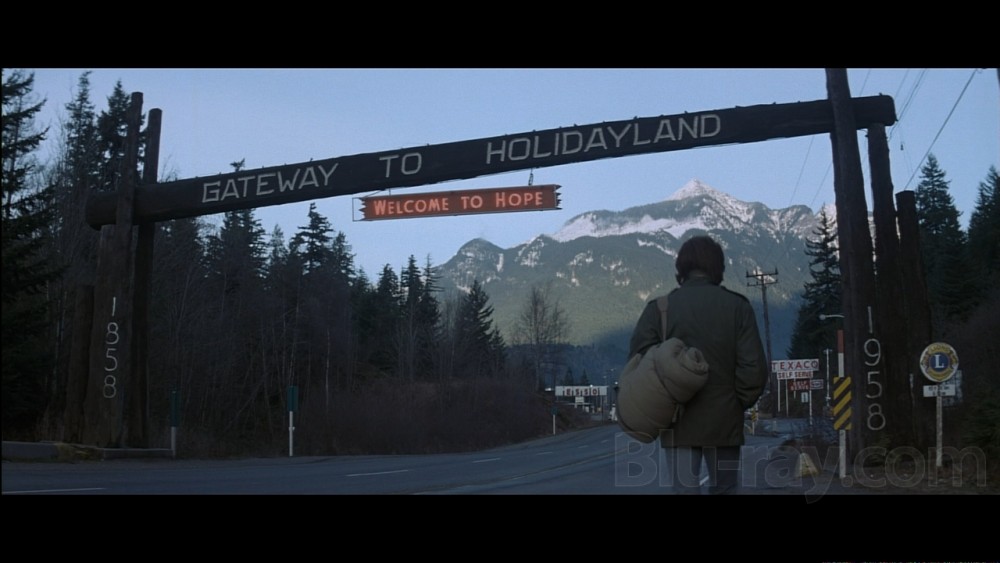
Though the sign isn’t in its original location anymore it still exists a few hundred meters past that spot.
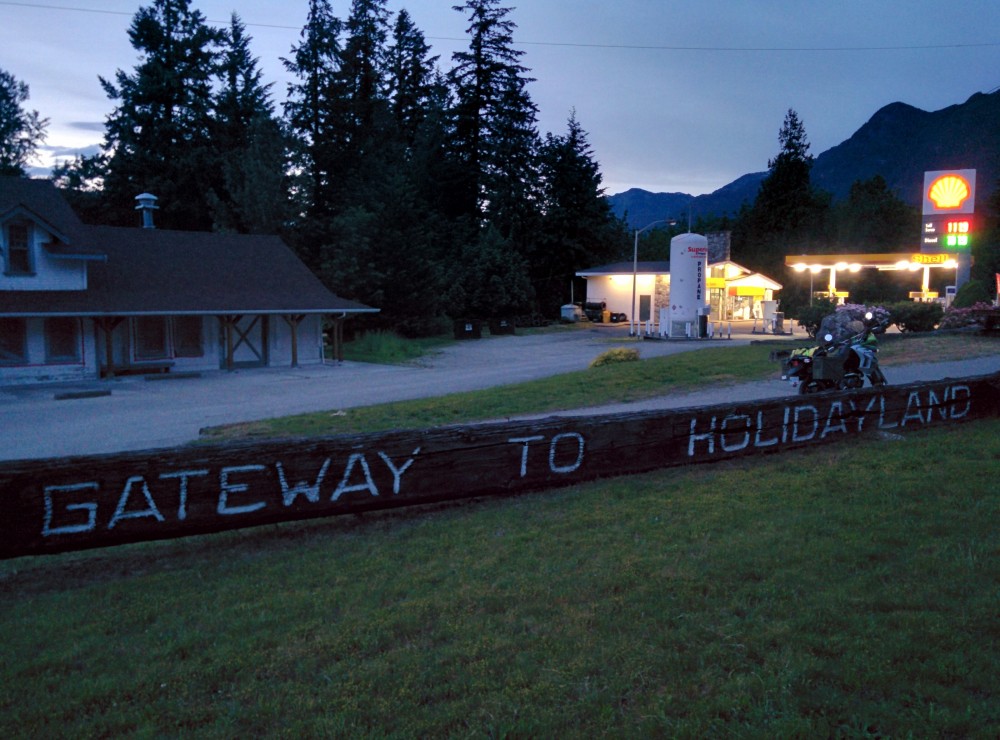
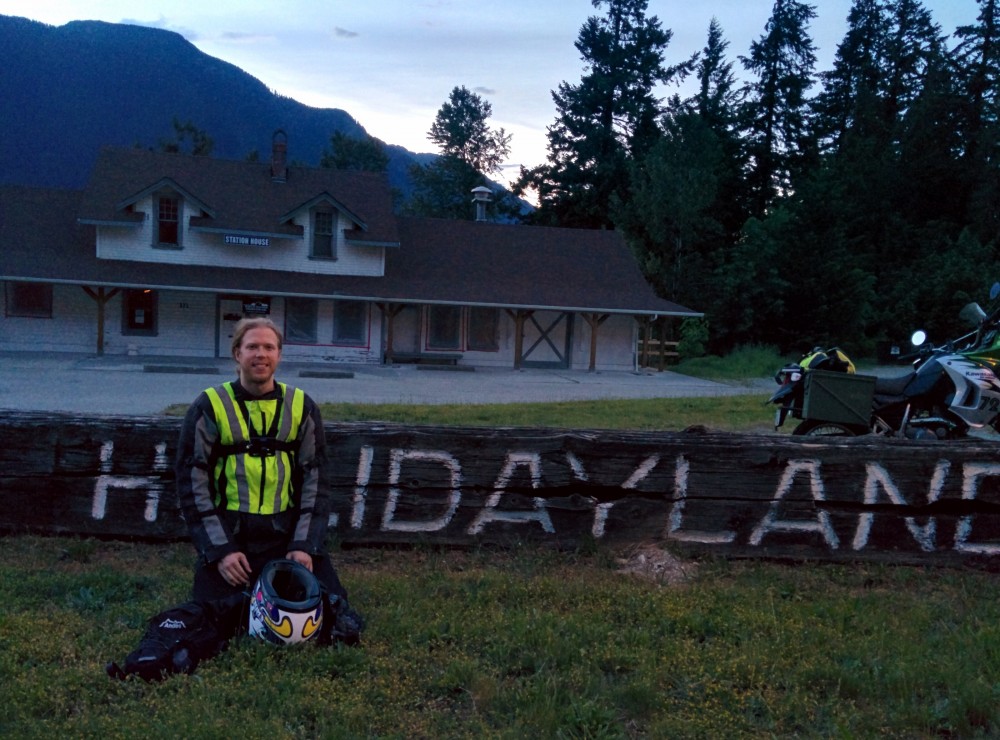
The Shell gas station you can see in the picture above is later being blown up by Rambo. It was rebuilt in the same spot.

After entering the town Rambo soon meets his nemesis Sheriff Teasle (Brian Dennehy) for the first time. Teasle feels that being a Korean war veteran himself he was forgotten and never got any recognition by the American public while Vietnam veterans like Rambo were getting all the attention. This unspoken premise sparks the madness that ensues across the following two hours of movie history.
Note the Chevron Gas Station in the back (blue-red arrows).

Teasle was blocking Rambo’s path coming from the exit on the right.
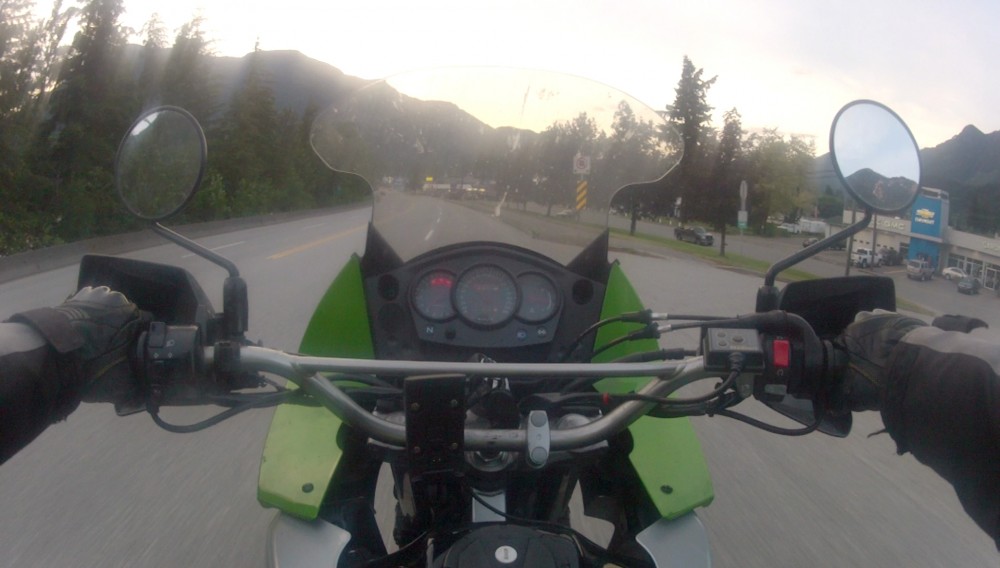
A little ahead the Chevron gas station also still exists.

Later Rambo shoots through it on a motorcycle trying to escape from Teasle.
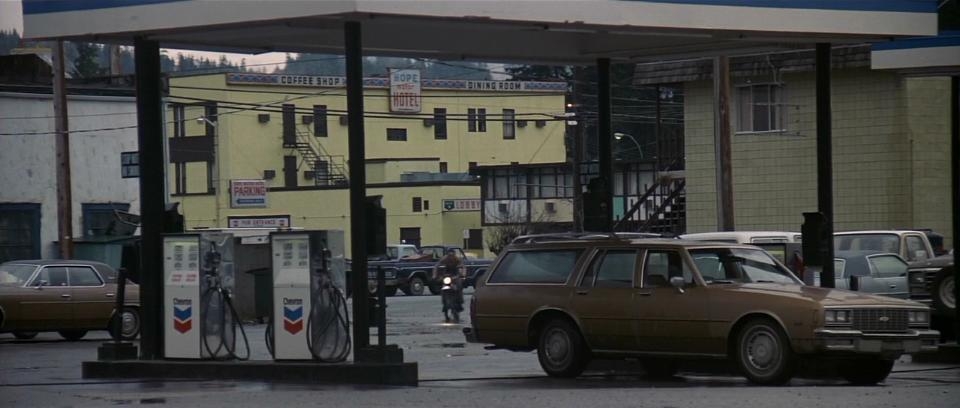
Leading up to this chase Rambo gets arrested by Teasle for bogus reasons (vagrancy and resisting arrest if I recall correctly) and brought to the local police station. The movie featured the real police station of Hope.
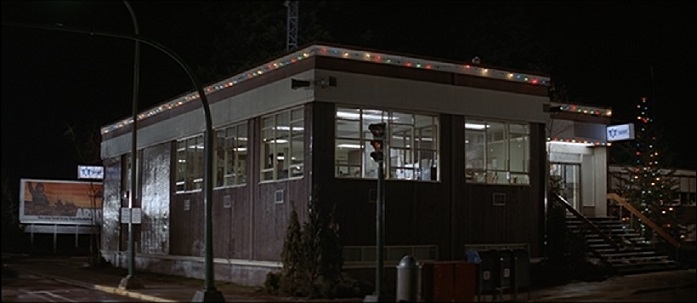
Note the white building outside with the red letters. (Also young Horatio Caine/David Caruso from CSI Miami in the background.)
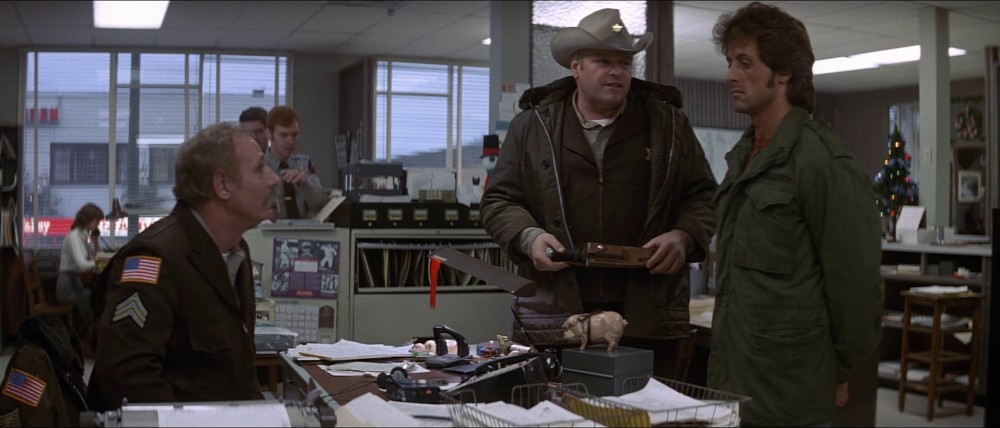
Like Rambo does, he later blows up the police station too which is why this building is gone today and in it’s place there is a little park with a wooden sculpture. Looks to me like the city of Hope abandoned the concept of ‘police’ after what happened in 1982 because I haven’t seen a new police station in the town. I don’t blame them.
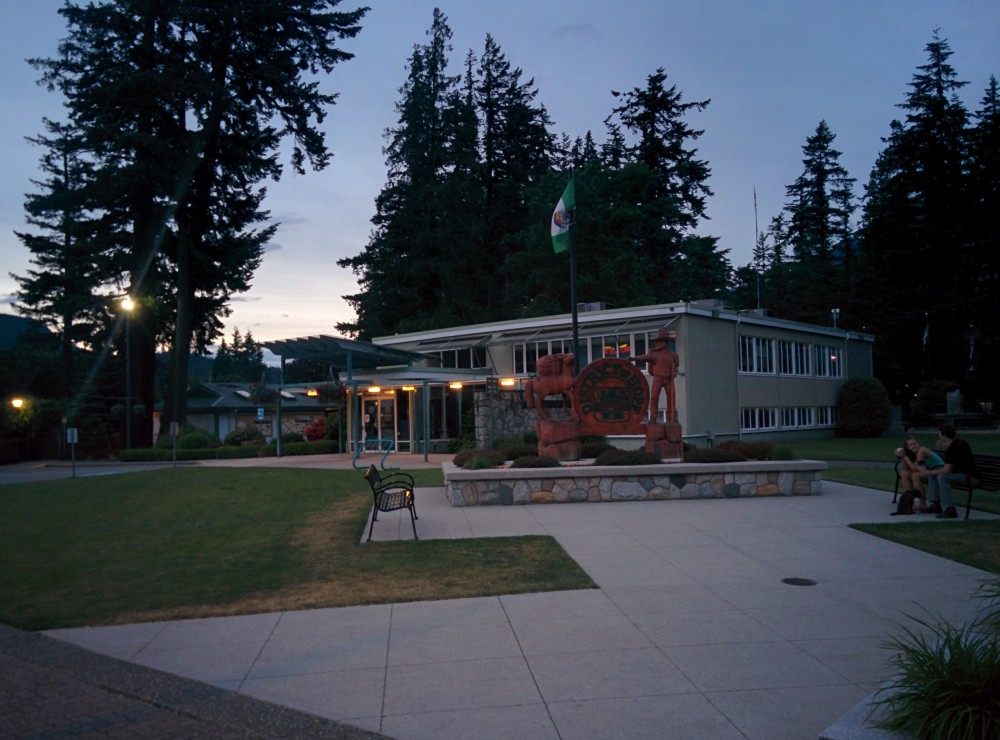
After having been arrested Rambo soon bust out of jail and steals the motorcycle mentioned earlier. (Yamaha XT250)
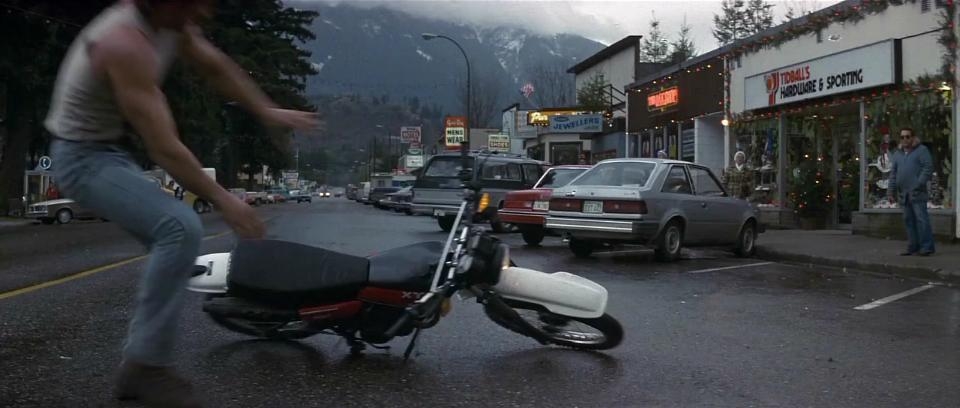
The same location today. (Kawasaki KLR 650)
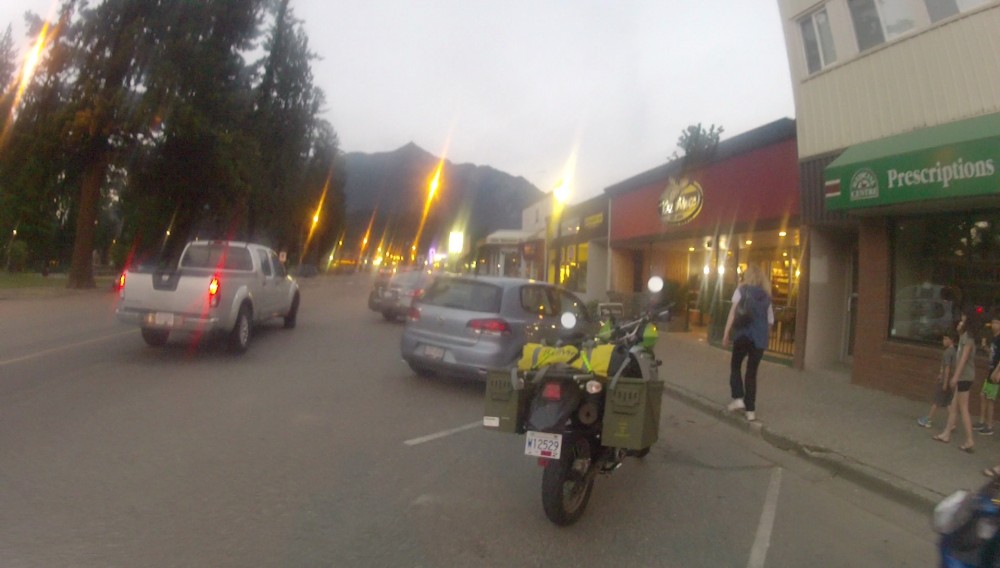
Looking the opposite direction: Rambo takes off. In the back, the white building with the red letters.
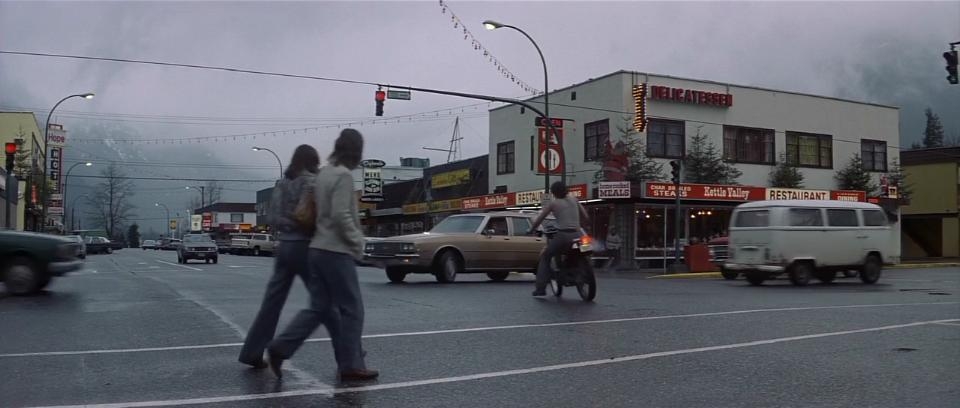
Rambo’s perspective today. The building which could be seen from the police stations window has been repainted since.
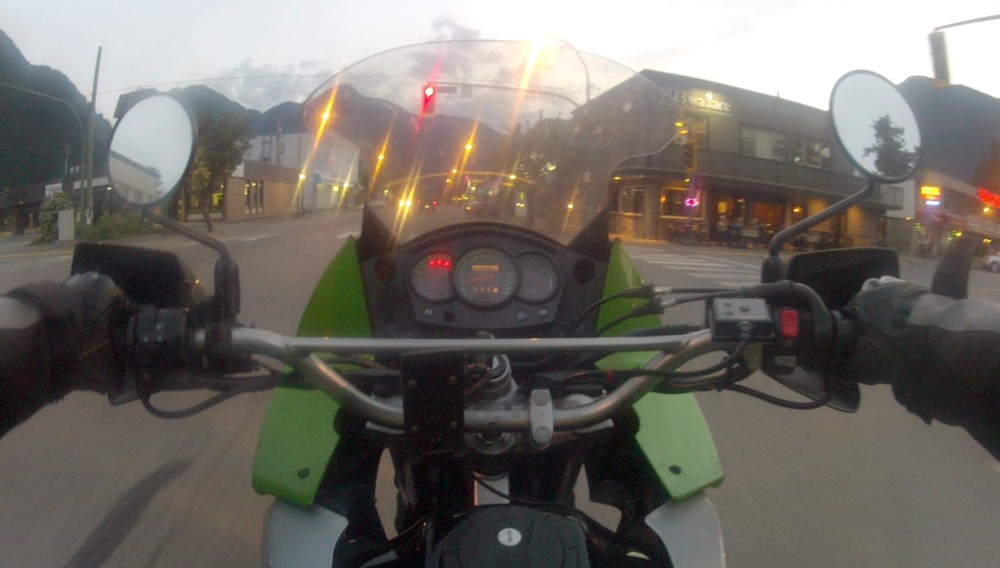
To avoid road traffic and to shake off Teasle (who follows Rambo in his police cruiser) Rambo drives on the sidewalk at high speed. Stallone did most of his stunts himself and also got badly insured when jumping from a cliff onto a tree. Several times.
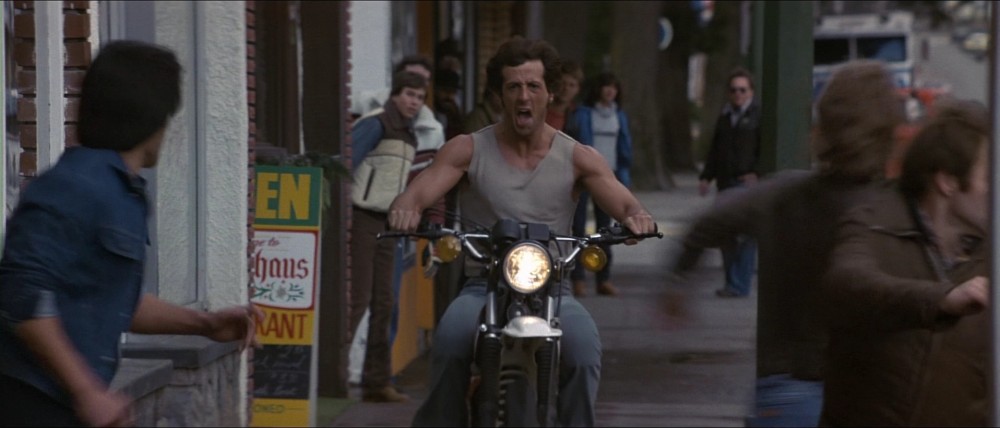
The sidewalk today. In the frame above Rambo just passed the red car to my right.
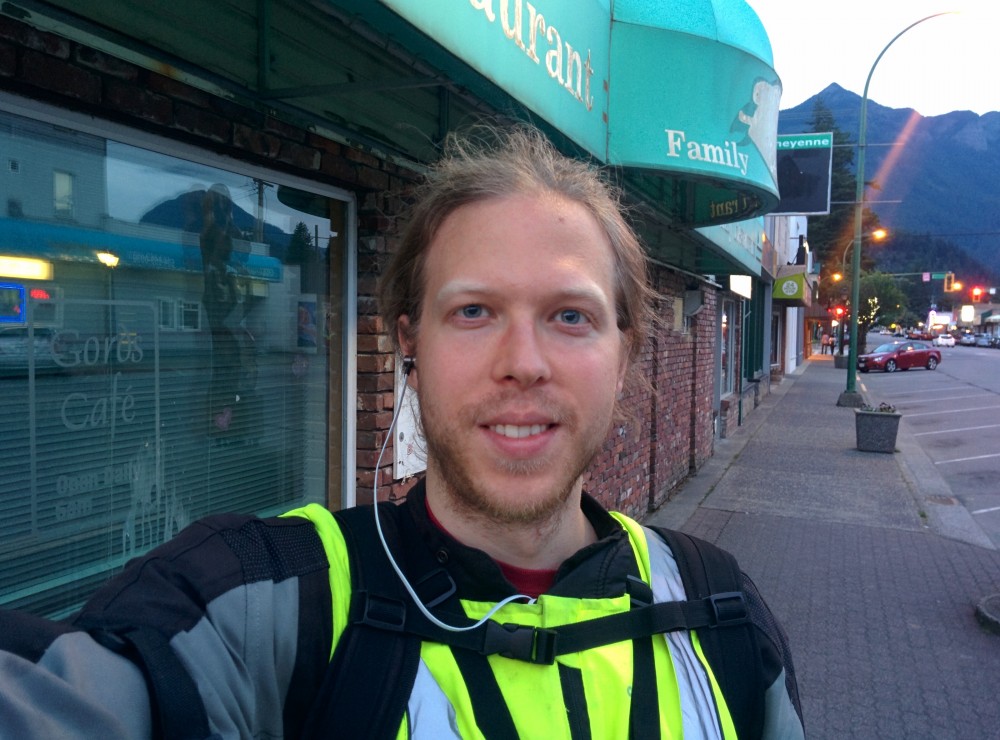
Rambo (John J.) heads for the mountains in hopes of losing Teasle there.
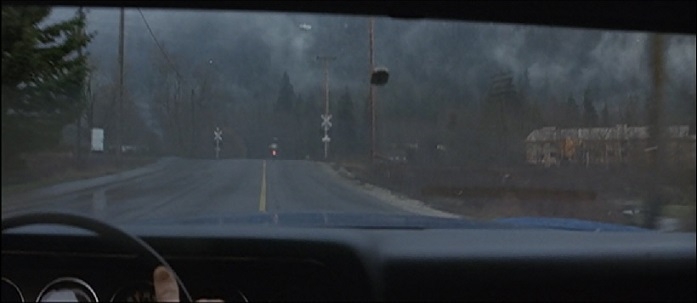
The same railroad crossing he passes in the movie is still in operation today.

The production didn’t bother repainting the ambulances of British Columbia which deal with the wounded that Rambo leaves behind. Unlike in the book Rambo never actually kills anybody in the whole movie. Stallone insisted on this change to make the character more likable and identifiable and to not send the wrong message about returning Vietnam war veterans, dehumanizing them on camera even more than the public was already doing.

BC’s ambulances still look the same today.
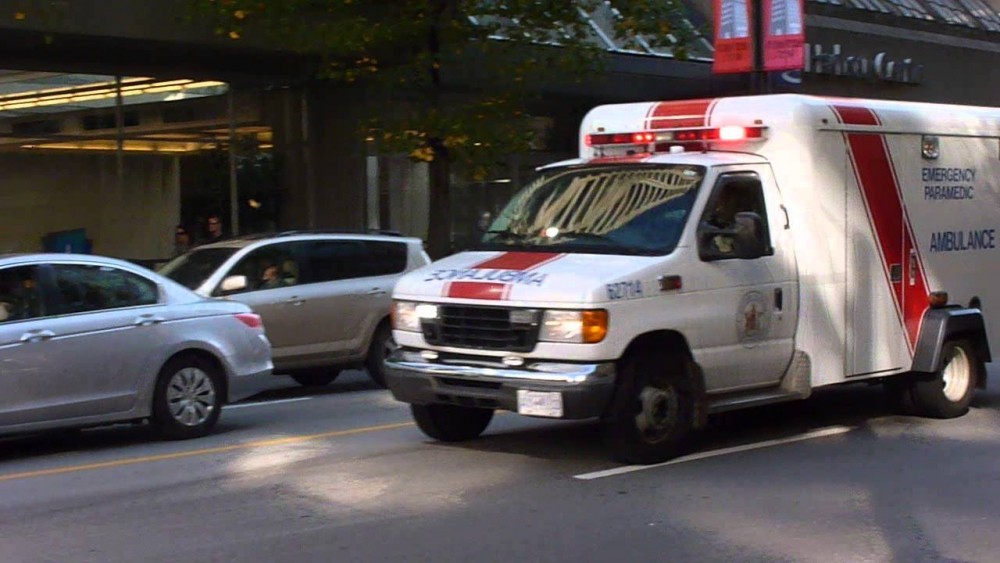
After having been chased through the woods Rambo is back in the town looking for refuge. This time he is not unarmed.
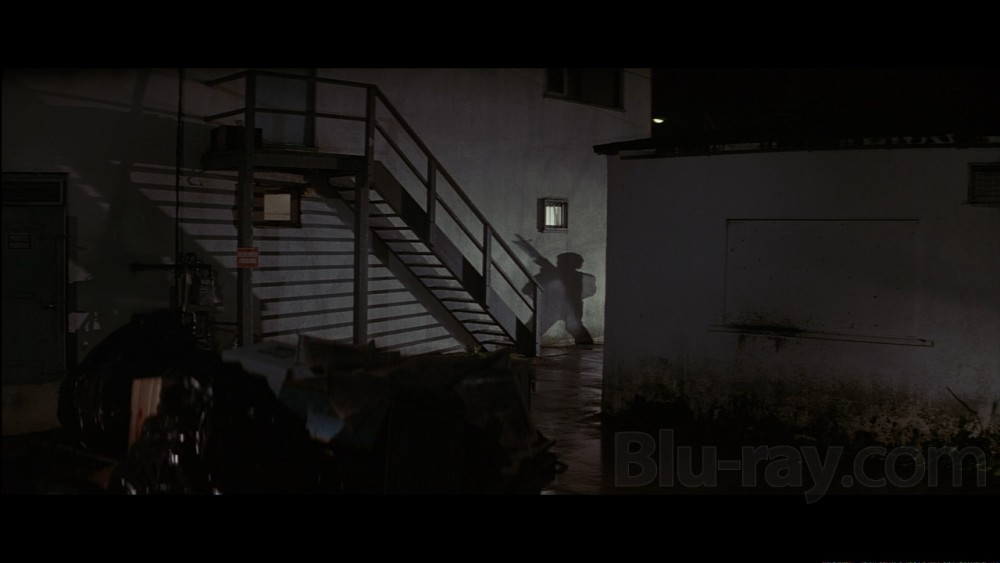
The same location today.
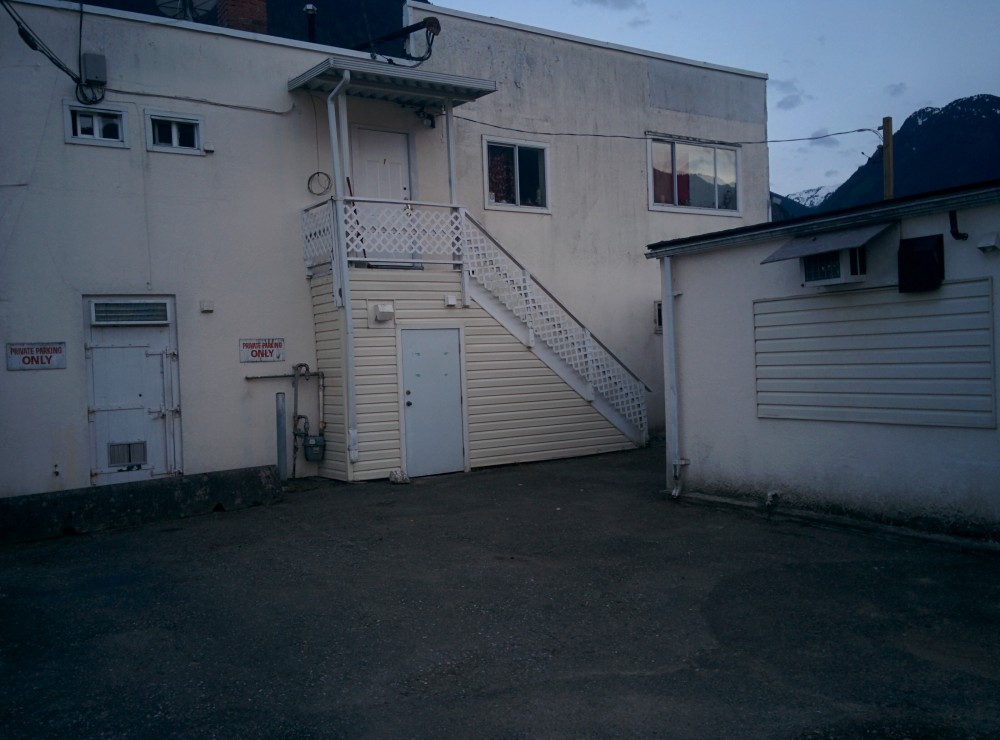
This is where I ended my Rambo tour. It was getting dark and I still had a few hundred km of riding ahead of me. If you haven’t seen the movie go watch it! It’ might surprise you.
I left Hope one more time passing the spot where Rambo makes his first appearance.
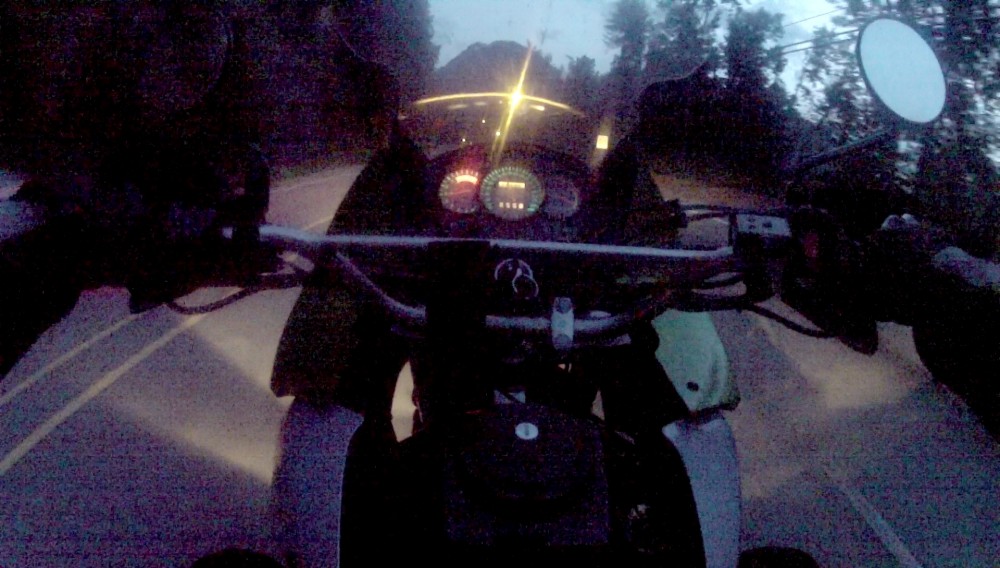

I decided to get a Kawasaki KLR 650. The cheapest powerful enough dual sport bike on the market. As you can imagine it’s balance between power, quality and cost. But it does what it is supposed to do and has proven itself over the past two decades during which this model has only gone through one major update which to a large degree was a cosmetic one. Never change a running system Kawasaki probably though. It’s the most popular dual sport bike in North America.
My brother (who also lived in Canada until recently) had a KLR and since he happened to move I was in luck and ‘inherited’ his bike.
Motorcycle insurance is stupidly expensive in British Columbia. It’s so expensive that if you were to get full comprehensive coverage for two years you’d be better off buying a new (used) bike every two years. The cost drop by 80% (!!!) if you have had your car drivers license for 10 years (I still need 3 more years). Yes, don’t ask me how that makes sense.

My brother had bought old (empty!) ammunition cans from the US and mounted them to the bike as panniers. They are just the right dimensions, surprisingly sturdy and even water sealed. Just a lock is missing but there’s a solution for that too.
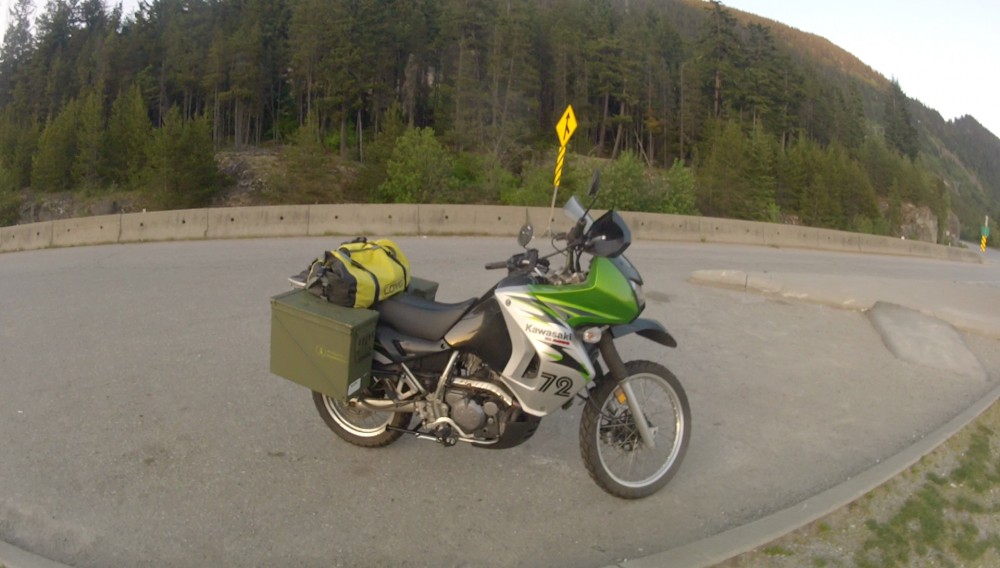
To get the bike ready for adventures I installed the SW Motech center stand he had gotten but not yet mounted. Having a center stand is crucial for maintenance work on the road like changing tires, changing the oil, adjusting/changing chain and sprockets,…
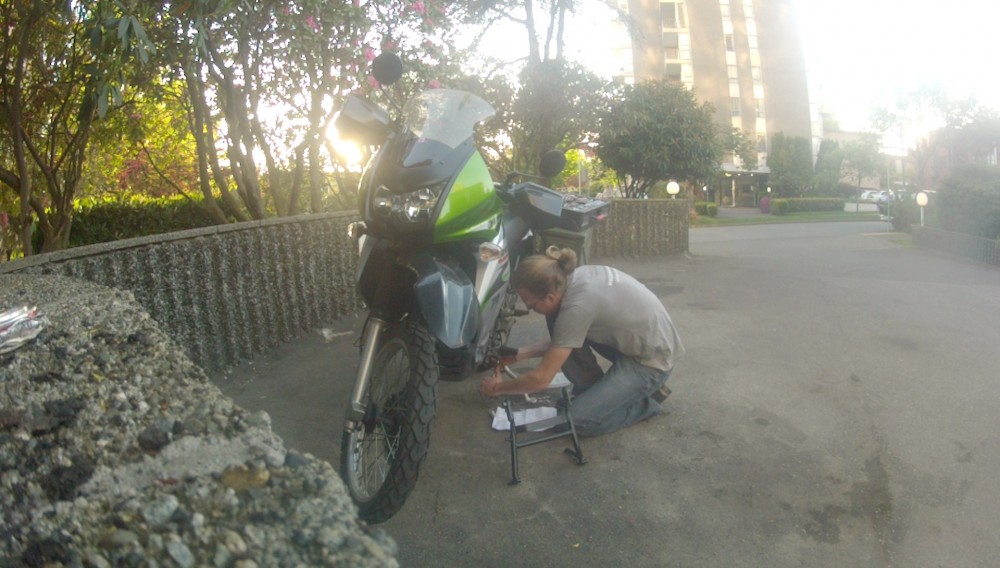
The procedure was simple. I took off the foot pegs on both sides to put two mounting plates between them and the frame which would serve as attachment points for the stand.
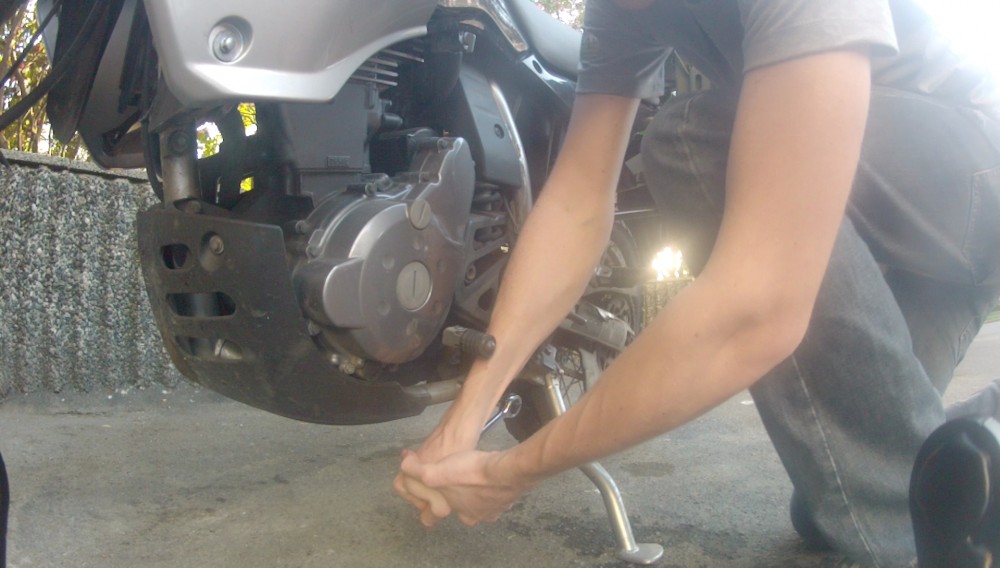
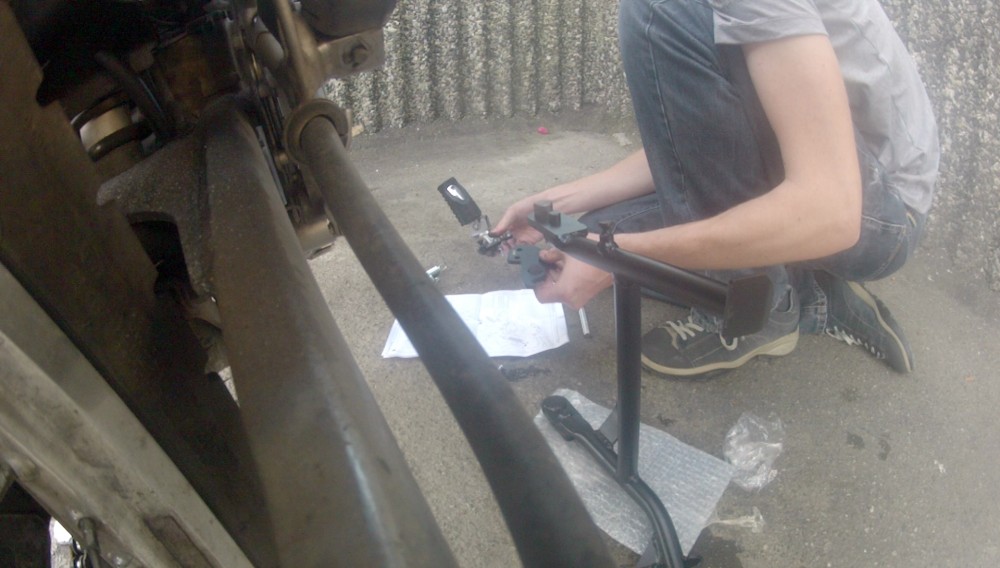

This was quickly done and the only thing left was to attach the two springs which keep the stand off the ground when the bike is not currently sitting on it.
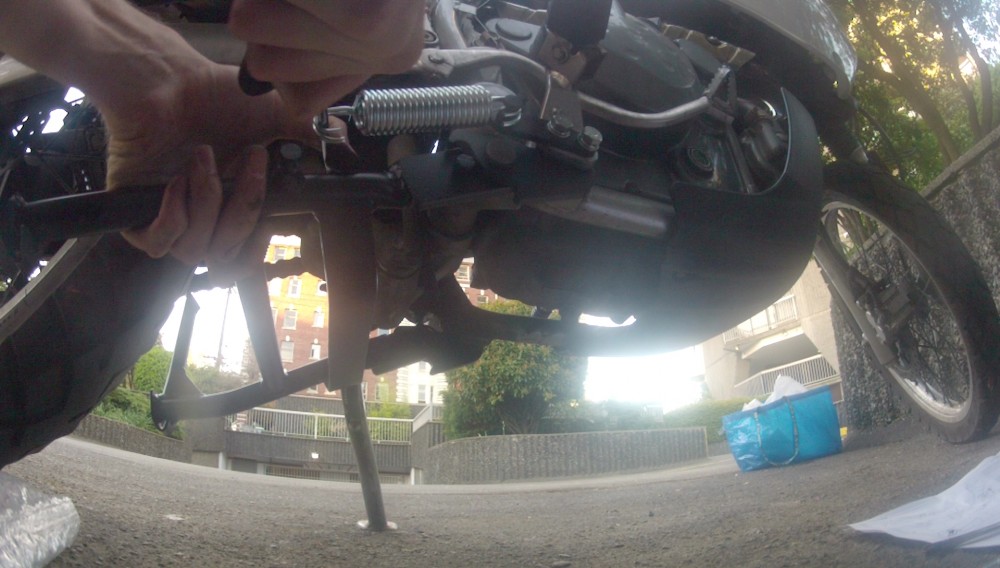
To lift up the weight of the bike there is a leaver on the stand on which you can place your foot and put your whole body weight on it while simultaneously yanking the bike up and backwards with your right hand.
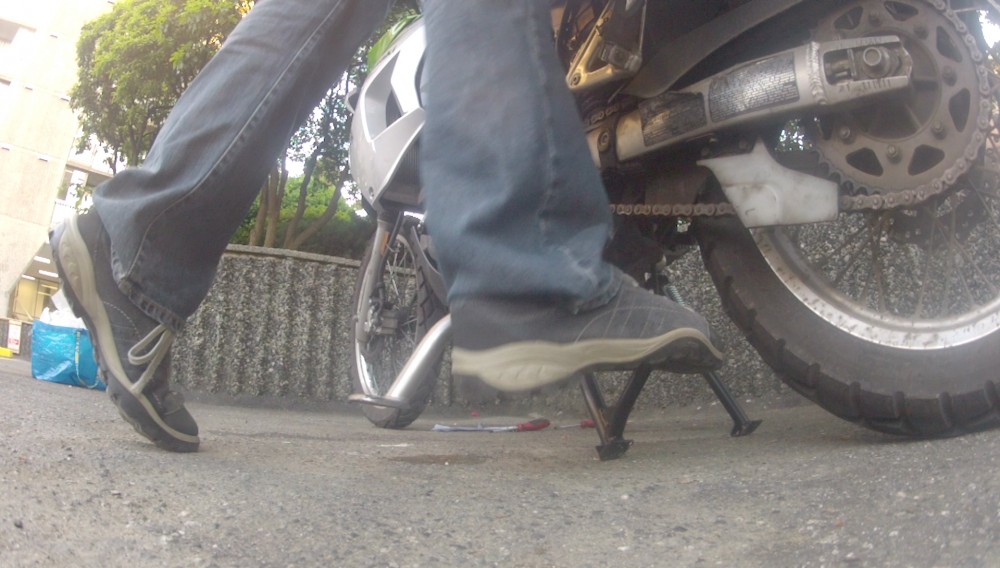
With the necessary force and leverage the bike slides back lifting the rear wheel off the ground. And because the stand is almost exactly in the middle it is also possible to easily tip the bike to the back to access the front wheel allowing maintenance on both wheels.

This is the undeniably true tourism slogan of the most western Canadian Province bordering the USA, British Columbia. After a few months of working in Germany I signed a contract with Image Engine, in Canada. I decided it was best to leave my BMW at home in Vienna and look for an alternative in Canada.
Like most major Canadian cities Vancouver borders the US in the South. The city is know for it’s rainy climate during fall and winter. There is no such thing as London weather once you have experienced Vancouver during this period. Spring and summer however make up for it big time.
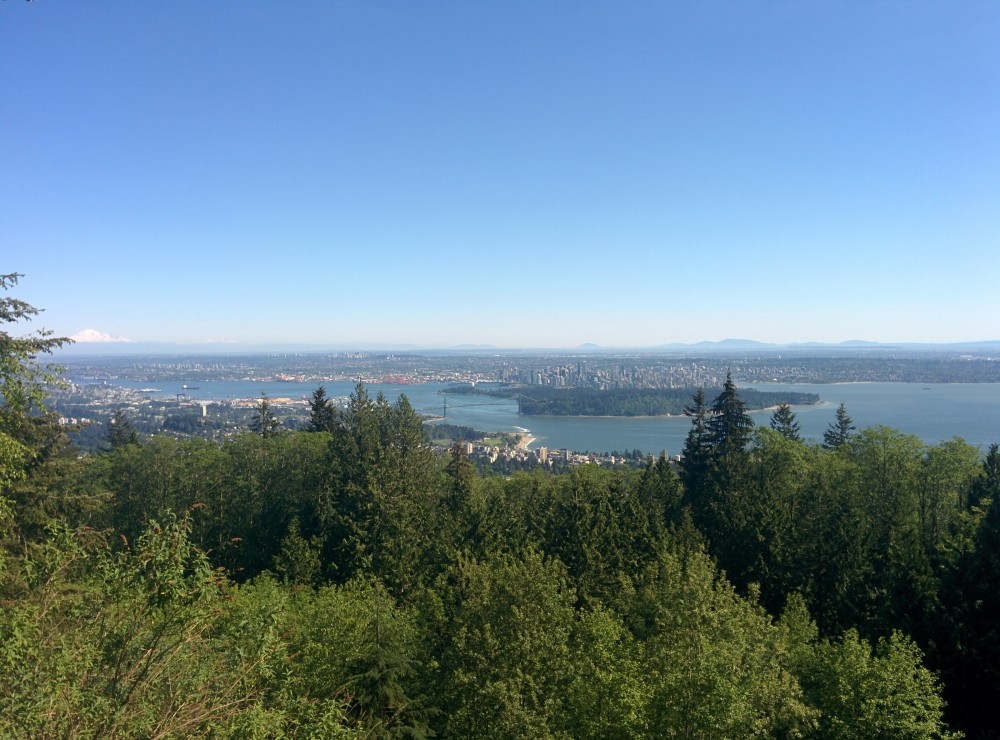
The ‘little’ green peninsula on the center right on the image above is Stanley Park. It’s one of the biggest city parks in the world and unlike most parks it is not perfectly cultivated. It’s the same kind of rain forest you can find anywhere else in B.C. The park is named after Lord Stanley who was one of the first kind of prime ministers of Canada. He is also name giver to the Stanley Cup, the big final tournament of each season of the (North American) National Hockey League (NHL).
The look of the Vancouver skyline is dominated by apartment buildings of which each floor has balconies, surprisingly all the way to the top.

Vancouver is ideal for any kind of outdoors sports. Lot’s of biking routes and hiking opportunities. Kayaking and rowing are also very popular. Some people even play hockey!

While Vancouver globally speaking is a very new city it is astounding to find out that tall buildings like this brick building below can be up to a century old.
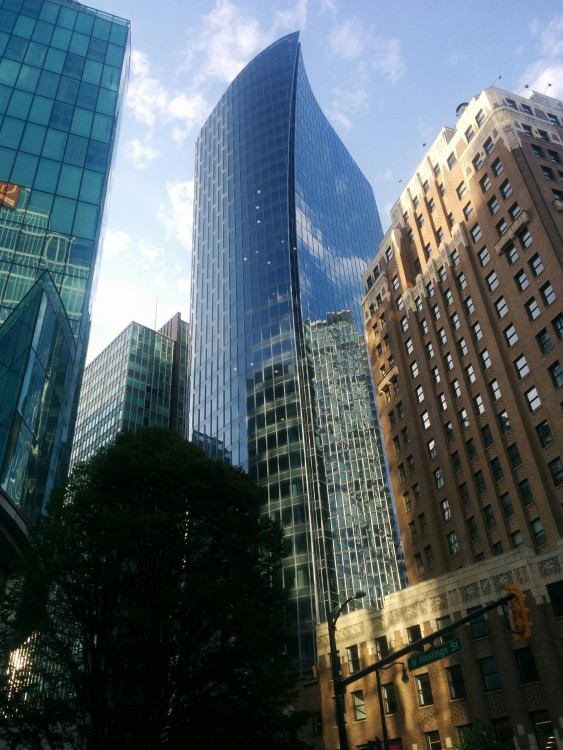
The city has one of the biggest China Towns which is often used for movie shoots to double as Asia.

Because the the city faces the sea in the west there are no mountains to block the sunset which is often very colorful.

Fishing is also big in Vancouver and naturally all along the coast like in the little fishing village of Steveston just a few dozen km south of metro Vancouver. Surprisingly in Vancouver fish is quite expensive. However here in Steveston the prices are very competitive. Freshly caught salmon is just a tad more expensive than chicken by the pound. (Unlike the US Canada seems to be on the fence about whether to use imperial or metric units so they use a bit of both..)
